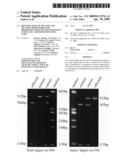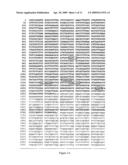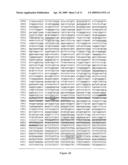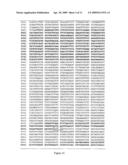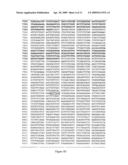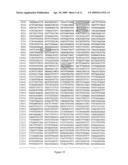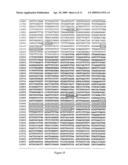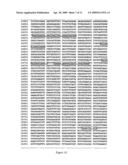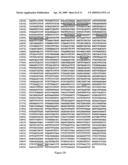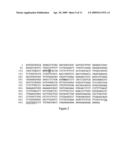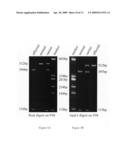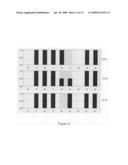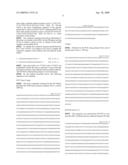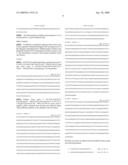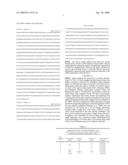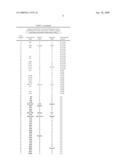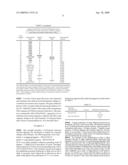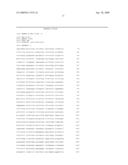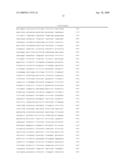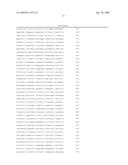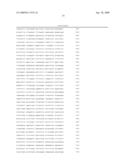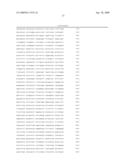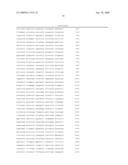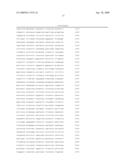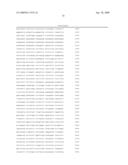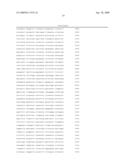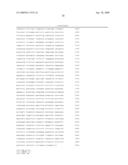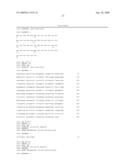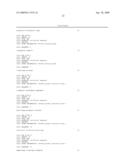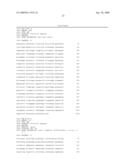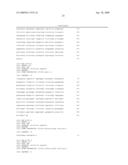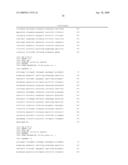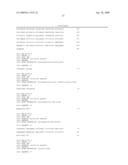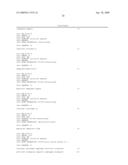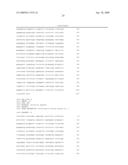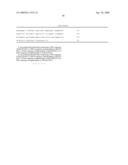Patent application title: Identification of the gene and mutation responsible for progressive rod-cone degeneration in dog and a method for testing same
Inventors:
Gustavo Aguirre (Philadelphia, PA, US)
Gregory M. Acland (Kennett Square, PA, US)
Gregory M. Acland (Kennett Square, PA, US)
Barbara Zangerl (Philadelphia, PA, US)
Orly Goldstein (Ithaca, NY, US)
Susan Pearce-Kelling (Berkshire, NY, US)
Jeanette S. Felix (Horseheads, NY, US)
Duska J. Sidjanin (Brookfield, WI, US)
IPC8 Class: AC07H2100FI
USPC Class:
536 231
Class name: Nitrogen containing n-glycosides, polymers thereof, metal derivatives (e.g., nucleic acids, oligonucleotides, etc.) dna or rna fragments or modified forms thereof (e.g., genes, etc.)
Publication date: 2009-04-30
Patent application number: 20090111976
Claims:
1. An isolated polynucleotide comprising a DNA sequence of SEQ ID NO:1, a
RNA sequence corresponding to SEQ ID NO:1, a DNA sequence complementary
to SEQ ID NO:1 or a RNA sequence complementary to SEQ ID NO:1.
2. An isolated polynucleotide comprising a DNA sequence of SEQ ID NO:3, a RNA sequence corresponding to SEQ ID NO:3, a DNA sequence complementary to SEQ ID NO:3 or a RNA sequence complementary to SEQ ID NO:3.
Description:
[0001]This application is a Divisional of U.S. application Ser. No.
11/157,743, filed on Jun. 21, 2005, which in turn claims priority to U.S.
provisional application No. 60/581,499, filed on Jun. 21, 2004, the
disclosures of which are incorporated herein by reference.
FIELD OF THE INVENTION
[0003]The present invention relates generally to a class of genetic diseases, observed in canines, termed progressive rod-cone degeneration ("prcd"). More particularly, the invention relates to a gene and a single nucleotide mutation in the gene associated with progressive rod-cone degeneration in dogs.
BACKGROUND OF THE INVENTION
[0004]Progressive Retinal Atrophy (PRA) is a heterogeneous class of retinal disorders that share a broadly similar clinical disease phenotype, and affect the dog (Canis familiaris) (Aguirre, 1976). The clinical features include: initial night blindness followed by reduction in photopic vision leading to complete blindness; reduction in retinal vessels, and retinal thinning; abnormalities in an electroretinogram ("ERG"); and the development of cataracts. Diseases of this group are typically inherited by means of an autosomal recessive gene defect although dominant and X-linked forms of PRA also are recognized (Kijas et al., 2002; Zhang et al., 2002). PRA may be classified into developmental and degenerative diseases. The developmental class comprises several genetically distinct diseases expressed cytologically in the immediate postnatal period when visual cells in the canine retina begin to differentiate (Acland et al. 1989). In contrast, the degenerative class represents defects in which photoreceptor cells degenerate after having differentiated normally--this class includes the specific disease termed progressive rod-cone degeneration (prcd). This specific form of PRA is an autosomal recessively inherited, late-onset retinal degenerations affecting several different breeds of dog (Aguirre and Acland, 1988).
[0005]Mutations at the prcd `gene locus account for all of the autosomal recessive late-onset hereditary retinal degenerations recognized to date in dogs. By cross-breeding experiments, it has been determined that the prcd gene locus is responsible for progressive retinal atrophy in poodles (toy, and miniature), cocker spaniels (American, and English), Labrador retrievers, and Portuguese water dogs (see, e.g., Aguirre and Acland, 1988, Aguirre and Acland, 1991; Pearce-Kelling et al., 2002). Cross-breeding experiments suggest the same mutation in the F04 gene (which is gene responsible for prcd) is also present in several other breeds either in dogs affected with prcd; or carriers of the disorder. However, based on clinical and genetic parameters consistent with disease caused by mutations at the prcd gene locus, other breeds of dogs suspected of having prcd as the form of observed progressive retinal atrophy include akita, basenji, border collie, English mastiff, English springer spaniel, Havanese, lowchen, samoyed, standard wirehaired dachshund, Tibetan terriers, Bernese mountain dog, and miniature schnauzer. Depending on the breed of the dog, different mutations responsible for allelic variants of the prcd gene locus can regulate the rate of progression, but not the phenotype, of photoreceptor degeneration.
[0006]Clinical diagnosis of prcd disease is complicated by the need for sophisticated testing methods such as ERG, and by the late onset of the disease. The age at which the disease can be diagnosed by current methods may be past the dog's reproductive life. For example, in English cocker spaniels, progressive retinal atrophy may be diagnosed by ERG at three years of age, and by opthalmoscopy at 5-8 years of age. This late age of diagnosis results in the dissemination of the undesirable trait within the population, and an increase in the disease frequency.
[0007]The estimated prevalence of progressive rod-cone degeneration differs among affected breeds. It is believed that approximately 2% of Labrador retrievers more than 2 to 3 years old are affected with progressive rod-cone degeneration; if so, then the proportion of Labrador retrievers expected to be heterozygous at the prcd locus could be as high as 24%. In poodles and cocker spaniels, the disease rate is higher than that observed in Labrador retrievers, and hence, the carrier rate would be expected to be higher. From the results of a survey of Portuguese water dogs, the calculated carrier frequency is approximately 40%.
[0008]Traditional measures for controlling inherited diseases in a population included performing "test" matings to identify carrier dogs, and to eliminate the identified carriers from breeding programs, thereby reducing the frequency of genetic disease in a breed. In a test mating, the dog being evaluated as a potential carrier of the genetic disease is mated with a dog known to be affected with the disease. Progeny are then observed for absence or presence of the disease, and a litter equal to or larger than 6, all of which are unaffected offspring, typically "clears" the dog from being a carrier. While test matings have been effectively used for breeds having large litter sizes, and for diseases which are early onset, such a procedure is not practical for reducing the frequency of prcd. In addition to the disadvantages of test matings such as great expenses in time and effort incurred to clear a dog and that affected dogs can be born if the dog to be evaluated is a carrier, test matings are not particularly suited for detection of carriers of prcd because of the late onset of clinical symptoms associated with the disease, and because some of the breeds affected have small litters (too small for establishing statistical probability).
[0009]Although the gene carrying the mutation or mutations that cause prcd has previously been unknown, genetic linkage studies in prcd families have shown that the gene that causes the disease in dogs resides on the centromeric end of canine chromosome 9, an area that is homologous to the telomeric end of the long arm of human chromosome 17 (Acland et al., 1999; Sidjanin et al., 2003).
[0010]In spite of the extensive efforts in the art to find the gene responsible for prcd, until now the gene has remained elusive. Identification, isolation, cloning, and sequencing of the prcd gene would enable the design and manufacture of products useful for the diagnosis and screening for prcd. Therefore, there has been an ongoing need in the canine breeding industry for a genetic test that permits direct identification of dogs that have the prcd form of progressive retinal atrophy (e.g., before detectable onset of clinical symptoms), as well as permitting the genotyping of dogs at risk for prcd to establish if they are affected, carriers or genetically normal.
SUMMARY OF THE INVENTION
[0011]The present invention provides an isolated nucleic acid molecule encoding a novel disease-associated canine gene, referred to herein as the F04 gene. The invention further provides the F04 gene having a G to A mutation at position 1298 of SEQ ID NO:1. This transversion is associated with and is indicative of prcd.
[0012]The present invention also relates to a method for identifying dogs, which are genetically normal, carriers of, or affected with prcd disease. Genetically normal dogs are those in which both alleles of the F04 gene have G as the nucleotide at a position corresponding to nucleotide position 1298 of SEQ ID NO:1. Affected dogs or predisposed dogs are those in which both alleles of the F04 gene have A as the nucleotide at a position corresponding to nucleotide position 1298 of SEQ ID NO:1. Carrier dogs are those in which one allele of the F04 gene has G and the other allele has A as the nucleotide at a position corresponding to nucleotide position 1298 of SEQ ID NO:1. A change of G to A in the F04 gene at a position corresponding to nucleotide position 1298 of SEQ ID NO:1 is termed herein as the "prcd mutation". The nucleotide position 1298 in SEQ ID NO:1 also corresponds to nucleotide position 115 in the cDNA sequence shown in SEQ ID NO:3
[0013]The method comprises the steps of obtaining a biological sample from a dog and testing the biological sample to identify whether or not G is present at a position corresponding to nucleotide position 1298 of the F04 gene. In one embodiment, the method comprises detecting a G to A mutation at a position corresponding to nucleotide position 1298 of SEQ ID NO:1 in one or both alleles which is indicative of a dog that is a carrier of or a dog that is affected with (or predisposed to) prcd respectively.
[0014]The present invention also provides a method for selecting dogs for breeding. This method comprises obtaining a biological sample from a dog, testing the biological sample for the F04 gene having a prcd mutation in one or both alleles, and eliminating dogs with the prcd mutation from a breeding stock, or breeding the dogs with the prcd mutation with genetically normal dogs.
BRIEF DESCRIPTION OF THE FIGURES
[0015]FIG. 1 shows the genomic sequence of the canine F04 gene.
[0016]FIG. 2 shows the sequence of the cDNA from the canine F04 gene.
[0017]FIG. 3 is a representation of restriction endonuclease digestion of amplified products from genetically normal, carrier dogs or dogs affected with prcd. FIG. 3A shows digestion with the restriction endonuclease RsaI and FIG. 3B shows digestion with restriction endonuclease ApaLI.
[0018]FIG. 4 is an illustration of the experimental setup used to identify whether a dog is a carrier, is affected with or is normal with respect to the prcd mutation, using Pyrosequencing®.
DESCRIPTION OF THE INVENTION
[0019]This invention provides a nucleic acid molecule encoding a novel F04 gene located on chromosome 9 in dogs. The sequence of the wild type F04 gene is presented in FIG. 1 and details pertaining to the sequence are as follows.
Explanation of the Genomic Sequence
[0020]The genomic sequence of the F04 gene is 18592 bp long. The sequence listed in SEQ ID NO:1 includes, all polymorphisms identified heretofore. Nucleotide exchanges are shown in italics as follows: W=A/T; M=A/C; R=A/G; Y=C/T; S=C/G; K=G/T. Insertion/deletions are shown in italics and underlined. Sequence for the affected and alternative allele for all polymorphisms shown in the sequence are presented in a separate Polymorphism table (Example 2). Microsatellite at position 13,146-13,278 bp is also shown in italics and is boxed.
[0021]In the public domain canine genome sequence assembly (canFam1) dated July 2004 (http://genome.ucsc.edu/cgi-bin/hgTracks?org=Dog&db=canFam1&hgs- id=42443361), the F04 genomic sequence (SEQ ID NO:1) is localized incorrectly to chr18:26,568,308-26,586,788. We believe this is incorrect, as we have established through our BAC contig, and by FISH and meiotic linkage mapping that, as predicted by comparison to the homologous regions of the human and mouse genomes, this canine genomic region is properly located on CFA9. This discrepancy does not affect the accuracy or the utility of the tests described herein.
[0022]Throughout this sequence, proposed exons and UTR regions are shown in upper case letters and defined exons are bolded. Intronic regions are in lower case letters.
Exon 1: bp 1-1,367
[0023]Includes a TATA box at position 727-731, three CRX binding sites at positions 1,122-1,128; 1,159-1,165; 1,177-1,183 and the ATG signal indicating the start of the ORF at position 1,294-1,296 all underlined and boxed.
[0024]The prcd mutation at position 1,298 is shown in italics, bold and boxed. The mutation is a change of G to A and is shown as "R".
Exon 2: bp 1,650-1,718
Exon 3: bp 3,746-3,826
[0025]Includes the stop codon at position 3,765-3,767 shown underlined and boxed.
Exon 4: bp 4,161-4,256
3'UTR: bp 4,257-18,592
[0026]Within this region there are several potential adenylation signals which are pointed out underlined and boxed. The region entitled 3'UTR has also been shown to contain regions of alternative splicing (indicated in bold), which further defines within this region:
Exon 5a: bp 4,806-5,399
Exon 5b: bp 4,839-5,399
Exon 5c: bp 5,093-5,399
Exon 6: bp 6,558-6,665
Exon 7: bp 6,927-7,164
Exon 8: bp 7,547-7,720
Exon 9: bp 12,275-18,592
[0027]The deduced amino acid sequence of a putative protein encoded by the F04 gene, based on the sequence of SEQ ID NO:1, and assuming a start site at position 1294 is shown below as SEQ ID NO:2.
Met Cys Thr Thr Leu Phe Leu Leu Ser Thr Leu Ala Met Leu Trp Arg Arg Arg Phe Ala Asn Arg Val Gln Pro Glu Pro Ser Gly Ala Asp Gly Ala Val Val Gly Ser Arg Ser Glu Arg Asp Leu Gln Ser Ser Gly Arg Lys Glu Glu Pro Leu Lys--(SEQ ID NO:2)
[0028]In this case, the prcd mutation would result in cysteine (the 2nd amino acid) being replaced by tyrosine.
The F04 cDNA Sequence (see SEQ ID NO:3)
[0029]Several splice variants of the F04 gene have been identified, all of which include the same ORF. The shortest full length splice variant is 695 bp long; the cDNA (SEQ ID NO:3) for this variant of the F04 gene is shown in FIG. 2. Those skilled in the art will recognize that potential future identification of additional exons, that do not alter the F04 ORF as described herein (such as a noncoding exon 5' to exon 1, or 3' to exon 3), will not affect the demonstrated association of the prcd mutation with PRA or detection of the prcd mutation as described herein.
Explanation of the cDNA Sequence:
[0030]The cDNA sequence embeds the ORF of 165 bp, located at position 111-275 (both start and stop codon are highlighted in bold). The mutation is located within the ORF at position 115 shown in italics, bold and boxed (Normal allele=G; mutant allele=A). Other polymorphisms (for examples: Y=C/T, nt 312 SEQ ID NO:3, Polymorphism# 55, Table 1; and R=G/A, nt 633 SEQ ID NO:3, Polymorphism# 57, Table 1) in the 3'UTR are not disease associated because both alleles have been identified on normal chromosomes. All cDNAs that include the F04 ORF incorporate exon 1 (bp 1-184), exon 2 (bp 185-253), exon 3 (bp 254-334) and exon 4 (bp 335-695), however, partial cDNAs obtained using different primer sets establish that different splicing variants in the 3'UTR can include at least exons 5 and 8 as defined in the genomic sequence. Other features are the same as in the genomic DNA.
[0031]Detection of the prcd mutation in the F04 gene can be carried out in any suitable biological sample obtained from a dog. In a preferred embodiment, the biological sample is any tissue containing genomic DNA. Suitable sources of biological sample include blood, hair, mucosal scrapings, semen, tissue biopsy, or saliva. In one embodiment, the biological sample is blood.
[0032]Dogs carrying the prcd mutation in F04 gene may be detected by testing either the DNA or the RNA, using a variety of techniques that are well known in the art. The genomic DNA used for the diagnosis may be obtained from a biological sample as described above. The DNA may be used directly or may be amplified enzymatically in vitro through use of PCR (Saiki et al., Science, 239:487-491 (1988)) or other in vitro amplification methods such as the ligase chain reaction (LCR) (Wu and Wallace, Genomics, 4:560-569 (1989)), strand displacement amplification (SDA) (Walker et al., PNAS USA, 89:392-396 (1992)), self-sustained sequence replication (3SR) (Fahy et al., PCR Methods Appl., 1:25-33 (1992)), prior to mutation analysis. The methodology for preparing nucleic acids in a form that is suitable for mutation detection is well known in the art.
[0033]Detection of DNA sequence mutations, such as the prcd mutation in the F04 gene, can be accomplished by a variety of methods including, but not limited to, restriction-fragment-length-polymorphism detection based on allele-specific restriction-endonuclease cleavage (Kan and Dozy Lancet, 2(8096):910-912 (1978)), hybridization with allele-specific oligonucleotide probes (Wallace et al., Nucl Acids Res., 6:3543-3557 (1978)) including immobilized oligonucleotides (Saiki et al., PNAS USA, 86:6230-6234 (1989)) or oligonucleotide arrays (Maskos and Southern, Nucl Acids Res., 21:2269-2270 (1993)), allele-specific PCR (Newton et al., Nucl Acids Res., 17:2503-2516 (1989)), mismatch-repair detection (MRD) (Faham and Cox, Genome Res., 5:474-482 (1995)), denaturing-gradient gel electrophoresis (DGGE) (Fisher and Lerman et al., PNAS USA., 80:1579-1583 (1983)), single-strand-conformation-polymorphism detection (Orita et al., Genomics, 5:874-879 (1983)), RNAase cleavage at mismatched base-pairs (Myers et al., Science, 230:1242 (1985)), chemical (Cotton et al., PNAS USA, 85:4397-4401 (1988)) or enzymatic (Youil et al., PNAS USA, 92:87-91 (1995)) cleavage of heteroduplex DNA, methods based on allele specific primer extension (Syvanen et al., Genomics 8:684-692 (1990)), genetic bit analysis (GBA) (Nikiforov et al., Nuci Acids Res., 22:4167-4175 (1994)), the oligonucleotide-ligation assay (OLA) (Landegren et al., Science, 241:1077 (1988)), the allele-specific ligation chain reaction (LCR) (Barrany, PNAS USA, 88:189-193 (1991)), gap-LCR (Abravaya et al., Nucl Acids Res., 23:675-682 (1995)), and radioactive and/or fluorescent DNA sequencing using standard procedures well known in the art.
[0034]Further, several new techniques have been described including dynamic allele-specific hybridization (DASH), microplate array diagonal gel electrophoresis (MADGE), Pyrosequencing®, the TaqMan system as well as various DNA "chip" technologies such as the Affymetrix polymorphism chips. These methods require amplification of the target genetic region, typically by PCR. Still other newly developed methods, which may not need PCR are based on the generation of small signal molecules by invasive cleavage followed by mass spectrometry or immobilized padlock probes and rolling-circle amplification. Several of the methods known in the art for detecting specific single nucleotide polymorphisms are described in U.S. Pat. No. 6,720,141 and the description of these methods is incorporated herein by reference.
[0035]As will be appreciated, the mutation analysis may also be performed on samples of RNA by reverse transcription into cDNA therefrom.
[0036]Any one or any combination of such techniques can be used in accordance with the invention for the design of a diagnostic device and method for the screening of samples of DNA or RNA for prcd gene mutation of G to A at a position corresponding to nucleotide position 1298 of SEQ ID NO:1 of the F04 gene. Thus, in accordance with the invention, there is provided a nucleic acid based test for prcd gene mutation which comprises providing a sample of a dog's DNA or RNA and assessing the DNA or RNA for the presence of the prcd mutation. Samples of dog DNA or RNA (or genomic, transcribed, reverse transcribed, and/or complementary sequences to the prcd gene) can be readily obtained. Through the identification and characterization of the F04 gene as taught and disclosed in the present invention, one of ordinary skill in the art can readily identify the genomic, transcribed, reverse transcribed, and/or complementary sequences to the prcd gene sequence in a sample and readily detect differences therein.
[0037]Accordingly, in one embodiment, the present invention provides nucleic acid fragments for detection of nucleic acids wherein the mutation is present. In general, the detection methods are based on DNA hybridization techniques, wherein hybridization to DNA sequences is performed under stringent conditions such that a change in one nucleotide can be detected. Optimal stringency is normally obtained by adjusting the reaction temperature and/or salt concentration so that the probe will only hybridize to its specific target, although those skilled in the art will recognize that alternative methods of optimizing for target specific hybridization are readily available.
[0038]Thus, allele-specific probes can be hybridized under conditions that are sufficiently stringent so that there is a significant difference in the intensity of the two alleles. Preferably, the hybridization conditions are sufficiently stringent so as to produce an essentially binary response (i.e., the probe hybridizes to one but not the other allele).
[0039]Further, primers can be designed which hybridize to a target sequence such that upon amplification, products are generated which contain the prcd mutation site. The primers should be long enough to be useful in reactions such as polymerase chain reaction (PCR) process or as probes in a ligase chain reaction (LCR) procedure. Generally fragments which are at least twelve bases in length are considered suitable for amplification reactions. The amplification products can be subjected to restriction endonuclease treatment and identified by denaturing gradient gel electrophoresis so as to distinguish between the amplification products from the two alleles.
[0040]Suitable fragments useful for hybridization can be identified from the sequence of the F04 gene presented herein or may be identified by hybridization to the nucleic acid sequence of the F04 gene (SEQ. ID. NO:1) or the cDNA (SEQ ID NO:3) under stringent conditions as described above.
[0041]By using the tools and method described herein, dogs which are genetically normal for the disease (G in both alleles), carriers of the prcd disease (G to A transversion in one allele) and dogs which are affected by (or predisposed to) progressive rod-cone degeneration (G to A transversion in both alleles) can be identified. Upon identification, such affected (or predisposed) or carrier dogs can be eliminated from the breeding stock. Alternatively, dogs which are affected (or predisposed) with prcd, or carriers of the prcd disease, can be mated with genetically normal (without the G to A transversion) dogs to ensure the absence in the litter of dogs affected with prcd.
[0042]This invention can be used for any breed of dog including, but not limited to, akita, American cocker spaniel, American eskimos, Australian cattle dog, Australian stumpy tailed cattle dog, basenji, Bernese mountain dog, border collie, Chesapeake bay retriever, Chinese crested, English cocker spaniel, English mastiff, English springer spaniel, Entlebucher mountain dog, Finnish lapphund, German shorthaired pointer, giant schnauzer, Havanese, Labrador retrievers, lowchen, miniature poodle, miniature schnauzer, Nova scotia duck tolling retriever, Portuguese water dogs, samoyed, silky terrier, spitz, standard poodle, standard wirehaired dachshund, Tibetan terriers, toy poodle. Because the identical prcd mutation in the F04 gene has been demonstrated to be present in, and cause PRA in so many different breeds, this mutation appears to have arisen long before the differentiation of the dog population into these different breeds. It is thus expected that the same mutation will prove to be present in other breeds of dogs in which its presence is not currently recognized.
[0043]The invention will be further understood by the following examples, which are intended to be illustrative and not restrictive in any way.
EXAMPLE 1
[0044]We have produced a retina specific canine EST library from 16 week old beagles. One set of 5 individual overlapping EST clones formed a contig which mapped to the previously specified CFA9 area (Sidjanin et al., 2003) and was therefore further investigated. This sequence contained the later defined F04 exon 8 (see below, EST clone contig, 1085 bp).
[0045]From sequence information from the above EST contig, and that of hypothetical human genes located within the corresponding region of the human genome sequence as deposited in GenBank, two primers were designed for RT-PCR: Forward: 5'-caccttggccatgctctggc-3' (located at the end of exon 1)--SEQ ID NO:4 Reverse: 5-aatgcatataaataaagcacttggc-3' (located in exon 8)--SEQ ID NO:5
[0046]RT-PCR was performed from a 3.3 week normal dog resulting in a 707 bp product (clone 9) spanning the end of exon 1, exon 2, exon 3, exon 4 and exon 8.
[0047]Comparative in silico analysis of canine genomic sequence from our BAC contig (see example 2, below), with public domain human and mouse genomic sequence, identified a highly conserved region, contiguous with the 5' end of clone 9, that included potential CRX binding sites followed by an ATG translation initiation codon immediately upstream to the sequence of clone 9, and predicted an ORF commencing with this ATG and ending with a stop codon in exon 3. This ORF sequence did not correspond to that of any known gene in Genbank, nor did its putative translation share recognizable domains with or sequence similarity to any other known protein in Genbank.
[0048]Because the F04 clone was identified from our retina-specific library, these data combined indicated that the ORF corresponding to F04 represents a novel, previously unrecognized, retina expressed gene. The presence of binding sites for the CRX photoreceptor-specific transcription factor, and the highly conserved structure of the region 5' to the identified start codon identified the putative exon 1 as the first coding exon of a retina-expressed gene. Based on this information a new primer set was designed to include the potential start codon and span exons 1-4:
Forward: 5'-ccagtggcagcaggaacc-3' (5' of exon 1)--SEQ ID NO:6Reverse: 5'-ccaagccagggcatgagc-3' (3' of exon 4)--SEQ ID NO:7
[0049]RT-PCR was performed on both, an 10.4 week normal animal and an 8.6 weeks prcd affected individual resulting in a 562 bp product in both animals (see below, RT-PCR exon 1-4). The only difference observed was a G to A change observed in the affected individual which consequently was identified as the prcd mutation.
[0050]To identify the 5' and 3' ends of this gene, we created a 5' RACE retina library from a 10 week old normal dog and a 8 week old affected dog. Amplification of the 5' ends was done with different specific primers located in exon 1 (CCAAGGTGCTGAGTAGGAAGAGGGTGGTG--SEQ ID NO:8). or exon 3 (AGTCCCTGGGGCCGAGCTCCGCCTGAC--SEQ ID NO:9). Amplification of the 3' ends was done using a specific primer located on exon 1 (CACCACCCTCTTCCTACTCAGCACCTTGG--SEQ ID NO:10) which is the exact complement sequence of the specific primer that is used to run the 5' RACE. Seminested PCR was done with a primer located on exon 3 (AGGGACTGGGATCAGCTGGCAGAGGCAG--SEQ ID NO:11) to verify specificity of the product.
[0051]The consensus sequence from these experiments is the clone we consider as the cDNA for the F04 gene (see Seq ID No:3) which is shown in FIG. 2. Details of the cDNA sequence are provided above.
[0052]To validate the consensus sequence predicted from the 5' and 3' RACE, two primers were used to amplify the consensus sequence from affected and non-affected retina cDNA.
TABLE-US-00001 5'-AGTGGCAGCAGGAACCTCAGG-3' SEQ ID NO:29 5'-GGATTATATTAGGGATGAATGAGAAG-3' SEQ ID NO:30
[0053]Since the results of a 5' RACE and a 3' RACE are independent results this step is necessary to prove that this transcript is present in the affected and non-affected Retina. The RT-PCR confirmed the presence of such transcript.
[0054]By the method described above, the following sequences were obtained.
EST Clone Contig:
[0055]The clones originally contained in the EST library produced the following consensus sequence from 5 clones; 1085 bp:
TABLE-US-00002 SEQ ID NO:12 GAGCAGCTGCAGCAGCTGCCACTGCCCTGTGTCACCCCAGGGTGCAAATG CCACCACGGGGAGCACCCCGCCCATCCCGAACTGTGTGGCTGTGCAGATG CGGGCAGGATGGTCCTGGGCACAGGCCTTGGTCCAAGACCAGGCAGGCGT GGTACTTGATCTGAGGTGGGCATCATGGCACAGGAGCTGGTCCCAGGGGT GCCCGGGGACCTTTATAGAACCTCAGTCGGGAAGAAGCCCAAGACCTTGA GCCAGAGGGAAGTAATGCTTCTTTGTGAGCCTCAAAAGGAGGGAAATGGC CAAGGTTTACAGTAATATAATGACACTAATATTATTATTAATAATGGCTA ATGTGTCTCAAACGCTTCTTACGTGCTAGGCGCTGTGCCAAGTGCTTTAT TTATATGCATTGTCTCATTTATGGGGCAGGAACTGTTGTCAGTCTCATTT ACCCAATAAGGAAAGTGCTTGCTCAAGGTCACCCACAGTGAGTAGTGAAG CCAGGACGTGTTCCCCGGCAAGGTGATGTAAAAGCCTGTGAAGGTATTGG GCCTCGAGGACATCCTGGGAGTGTGACCTGTCCACCAGGGCACAGGGCAT GAGAGCTGGCAACCCTCCCTGGTGATACTGCCGCTGCTCAGTCTGCAGAA ACTCATCATTCCAGGCTGGACCAGACTCTGGGCCCCGAGGGCAGTGACCA GAGCCACCTTTCCAGGATCTGTCATGCTCCTCAGGGAGGAAGCAGTGGCC ACTGGCAGGGATGACAGATATCAAGGTTGTCACTCATTGCTGCTGTTGCT CTGCTGTTTCCTCCAACCAGGGGCAGAGCCCTGGGGGTAAGGGAGGGTGG CAGCCAGCAGCCCAGCCAGAGAAGGAGGAGCCAGAGGAGGAAGGCTTTGT TGTTTGTTTTTACAGGGGGACGGTGCAGGGCTTTAAGGAGGTGGCTTCAA GACCTGCTGACTTTAGCCATAAACTGGTACCTAAGGGTGCTGGACCCTCT CTGTGGGATACATATGCCCCCTAGTGGGGATTAAGCCTGGAGGGTGGCTG AG:AAATTAAAGCAAAAAAAAAAAAAAAAAAAAAA
Clone9:
[0056]Produced by RT-PCR using primers from exon 8 and the end of exon 1 (707 bp):
TABLE-US-00003 SEQ ID NO:13 CACCTTGGCCATGCTCTGGCGCCGCCGGTTCGCCAACCGGGTCCAACCGG AGCCCAGCGGAGCAGACGGGGCAGTCGTGGGCAGCAGGTCGGAGAGAGAC CTCCAGTCCTCGGGCAGAAAGGAAGAGCCTCTGAAGTAAGTCTTCACCCG GTCAGGCGGAGCTCGGCCCCAGGGACTGGGATCAGCTGGCAGAGGCAGTT CAAGTCCCGGCTGGCCTCTTACCCACAAAGCATGCTGTGGTGGAAGCAGC AGCAGCAGCAAGAAGAAAAATGGGAAAAAGCAGTCATCAAGAAGGTAGAC TCCTCCCTTTGAGTCCCTGGACCTGCCTGGCCTCCCTTTGCCCCAGACCC TGGTGGTGGGGCTCCTGAAGCAAGGCCTGGCTGGGGCAGGCTGGAGGGCA AAGACGCTCATTGCCCTGGCTTGGGCTCCCTTCCTCTGAGATCCTGAGGA TAGTCTGAGGCAGGCCCAGAGAGGGACTCAGGTTTCTTATGGAAGGRCTT CTCATTCATCCCTAATATAATCCTTGCAATGACCCCAAGACCTTGAGCCA GAGGGAAGTAATGCTTCTTTGTGAGCCTCAAAAGGAGGGAAATGGCCNAG GNTTACAGTAATATAATGACACTAATATTATTATTAATAATGGCTAATGT GTCTCAAACGCTTCTTACGTGCTAGGCGCTGTGCCAAGTGCTTTATTTAT ATGCATT
RT-PCR Exons 1-4
[0057]This sequence was created from RT-PCR to compare the ORF of affected and non-affected animals (562 bp):
TABLE-US-00004 SEQ ID NO:14 CCAGTGGCAGCAGGAACCTCAGGATGGGCAGCAGTGGCTTGTGAGAGCCG GCAGGGCCATTTTGGCCTTTCTCCTGCAGACTCTGTCCGGGAGGGGATGG GGCAGCTGAGCCATGTRCACCACCCTCTTCCTACTCAGCACCTTGGCCAT GCTCTGGCGCCGCCGGTTCGCCAACCGGGTCCAACCGGAGCCCAGCGGAG CAGACGGGGCAGTCGTGGGCAGCAGGTCGGAGAGAGACCTCCAGTCCTCG GGCAGAAAGGAAGAGCCTCTGAAGTAAGTCTTCACCCGGTCAGGCGGAGC TCGGCCCCAGGGACTGGGATCAGCTGGCAGAGGCAGTTCAAGTCCCGGCT GGCCTCTTACCCACAAAGCATGCTGTGGTGGAAGCAGCAGCAGCAGCAAG AAGAAAAATGGGAAAAAGCAGTCATCAAGAAGGTAGACTCCTCCCTTTGA GTCCCTGGACCTGCCTGGCCTCCCTTTGCCCCAGACCCTGGTGGTGGGGC TCCTGAAGCAAGGCCTGGCTGGGGCAGGCTGGAGGGCAAAGACGCTCATT GCCCTGGCTTGG.
[0058]The F04 mutation is bolded and presented as a G in normal and an A in prcd affected dogs.
Splice Variants
[0059]In addition to alternative splicing observed in some of the sequences obtained throughout the cloning process of the F04 gene (described above), different splice variants were identified using RT-PCR with primers located in exons 2 and 3, and with primers located in downstream predicted exons (see below).
Clone 1:
[0060]RT-PCR was performed using a primer from exon 3 (CAGTCGTGGGCAGCAGGTCGG--SEQ ID NO:15) and one from exon 8 (AATGCATATAAATAAAGCACTTGGC--SEQ ID NO:16) producing a 316 bp product:
TABLE-US-00005 SEQ ID NO:17 CAGTCGTGGGCAGCAGGTCGGAGAGAGACCTCCAGTCCTCGGGCAGAAAG GAAGAGCCTCTGAAGTAAGTCTTCACCCGGTCAGGCGGAGCTCGGCCCCA GGGGTGCCCGGGGACCTTTATAGAACCTCAGTCGGGAAGAAGCCCAAGAC CTTGAGCCAGAGGGAAGTAATGCTTCTTTGTGAGCCTCAAAAGGAGGGAA ATGGCCAAGGTTTACAGTAATATAATGACACTAATATTATTATTAATAAT GGCTAATGTGTCTCAAACGCTTCTTACGTGCTAGGCGCTGTGCCAAGTGC TTTATTTATATGCATT.
[0061]Primers from exon 2 (GCAGCAGGTCGGAGAGAGAC--SEQ ID NO:18) and exon 5 (CTTCCCTCAGATGTGGAGTCAG--SEQ ID NO:19) were used to amplify cDNA obtained from normal and affected retina. Three different products were obtained as shown below.
TABLE-US-00006 Product number 1: SEQ ID NO:20 GCCACCGGGTCCACCGGAGCCCAGCGGAGCAGACGGGGCAGTCGTGGGCA GCAGGTCGGAGAGAGACCTCCAGTCCTCGGGCAGAAAGGAAGAGCCTCTG AAGTAAGTCTTCACCCGGTCAGGCGGAGCTCGGCCCCAGGGACTGGGATC AGCTGGCAGAGGCAGTTCAAGTCCCGGCTGGCCTCTTACCCACAAAGCAT GCTGTGGTGGAAGCAGCAGCAGCAGCAAGAAGAAAAATGGGAAAAAGCAG TCATCAAGAAGTTTCCAGGGCACTTGCCTCTCCCCGGTCCCCAGAGCTCA CCCCGTCACCAGCCACTCTGCTGCAGTTCTCAATAAGAAATGCCAGCTGG GATCTGTGACATGTCTGCCTGCGGCTGGAAGGAAGCATCTCTCAACCTGT CCTCTGAGCGTGTCTGCGTGCCTGTGTGCATGCGTGCGTGTGTTCCAAAG GGGCAGTCGCATGTGGGAAGGGAAGAAGCCTGACACTTGTTCTTGTCAAT CTGCTGACTGCTCAGTACCACGGCGGCTCTGCCATTTCTCCCTCACAGTC CTGCTCGACCCAGAGCAGAGATCAAAGCAGATTTCCGCTTCTGCTCCCTG AGATCCAGGCGCAGACCTGCAGGCAGCTGCTCCCCACTGTCTGGAAGCCA TTCATCATGCAAAGCGCCTCCCCACCAAACCCCTGCCTGCACGTGCATCG TCCCCCCACCATCACCATCCAGCCCCCAGGGTGGGCAGGGAGGTCCCTGC TAGCTGCACACCCCCCAGGCCATCAAGAGGCAGGAGATGGGGAGT. Product number 2: SEQ ID NO:21 GCCACCGGGTCCACCGGAGCCCAGCGGAGCAGACGGGGCAGTCGTGGGCA GCAGGTCGGAGAGAGACCTCCAGTCCTCGGGCAGAAAGGAAGAGCCTCTG AAGTAAGTCTTCACCCGGTCAGGCGGAGCTCGGCCCCAGGGACTGGGATC AGCTGGCAGAGGCAGTTCAAGTCCCGGCTGGCCTCTTACCCACAAAGCAT GCTGTGGTGGAAGCAGCAGCAGCAGCAAGAAGAAAAATGGGAAAAAGCAG TCATCAAGAAGAGCTCACCCCGTCACCAGCCACTCTGCTGCAGTTCTCAA TAAGAAATGCCAGCTGGGATCTGTGACATGTCTGCCTGCGGCTGGAAGGA AGCATCTCTCAACCTGTCCTCTGAGCGTGTCTGCGTGCCTGTGTGCATGC GTGCGTGTGTTCCAAAGGGGCAGTCGCATGTGGGAAGGGAAGAAGCCTGA CACTTGTTCTTGTCAATCTGCTGACTGCTCAGTACCACGGCGGCTCTGCC ATTTCTCCCTCACAGTCCTGCTCGACCCAGAGCAGAGATCAAAGCAGATT TCCGCTTCTGCTCCCTGAGATCCAGGCGCAGACCTGCAGGCAGCTGCTCC CCACTGTCTGGAAGCCATTCATCATGCAAAGCGCCTCCCCACCAAACCCC TGCCTGCACGTGCATCGTCCCCCCACCATCACCATCCAGCCCCCAGGGTG GGCAGGGAGGTCCCTGCCTAGCTGCACACCCCCCAGGCCATCAAGAGGCA GGAGATGGGGAGT. Product number 3: SEQ ID NO:22 GCCACCGGGTCCACCGGAGCCCAGCGGAGCAGACGGGGCAGTCGTGGGCA GCAGGTCGGAGAGAGACCTCCAGTCCTCGGGCAGAAAGGAAGAGCCTCTG AAGTAAGTCTTCACCCGGTCAGGCGGAGCTCGGCCCCAGGGACTGGGATC AGCTGGCAGAGGCAGTTCAAGTCCCGGCTGGCCTCTTACCCACAAAGCAT GCTGTGGTGGAAGCAGCAGCAGCAGCAAGAAGAAAAATGGGAAAAAGCAG TCATCAAGAAGTCCTGCTCGACCCAGAGCAGAGATCAAAGCAGATTTCCG CTTCTGCTCCCTGAGATCCAGGCGCAGACCTGCAGGCAGCTGCTCCCCAC TGTCTGGAAGCCATTCATCATGCAAAGCGCCTCCCCACCAAACCCCTGCC TGCACGTGCATCGTCCCCCCACCATCACCATCCAGCCCCCAGGGTGGGCA GGGAGGTCCCTGCCTAGCTGCACACCCCCCAGGCCATCAAGAGGCAGGAG ATGGGGAGT.
RT-PCR was done on affected and non-affected retina using the following primers:
TABLE-US-00007 5'-TTAATCAGTCTGCACAAGGTCG-3' SEQ ID NO:31 5'-GGGTCATTGCAAGGATTATATTAGG-3' SEQ ID NO:32
Two splice variants were observed:
TABLE-US-00008 Product number 1: SEQ ID NO:33 TTAATCAGTCTGCACAAGGTCGGGTTGGCTGACCCCACTAATCAGCTTGA GCCTCCTAATCCAGTGGCAGCAGGAACCTCAGGATGGGCAGCAGTGGCTT GTGAGAGCCGGCAGGGCCATTTTGGCCTTTCTCCTGCAGACTCTGTCCGG GAGGGGATGGGGCAGCTGAGCCATGTRCACCACCCTCTTCCTACTCAGCA CCTTGGCCATGCTCTGGCGCCGCCGGTTCGCCAACCGGGTCCAACCGTGA GAAGCTGATGGGGCCATGGGCAGGGATGGGGAGAGAGGAGAAGCTAGGGG GTGAGGGGTGGTGCAGGGGCTGCCTGGACCTCCTGGGAGGCTGGAGGGCG GGGAGGATTTGCAGGGAGGTCCAGAGAGGTTTCCCATCAGAGCACGCGGG GGCGGGGGCTCGCAGGTGCTCCGAGACTGGCTGGAGTCCCCGGTCCCCCA GCCCAACACGGCCAGGAGAGGGGGTTCTGGGCCCGGGCGCTGCCCACAGC TCTTCCAGCCTCTTCCTCCCGCCCACAGGGAGCCCAGCGGAGCAGACGGG GCAGTCGTGGGCAGCAGGTCGGAGAGAGACCTCCAGTCCTCGGGCAGAAA GGAAGAGCCTCTGAAGTAAGTCTTCACCCGGTCAGGCGGAGCTCGGCCCC AGGGACTGGGATCAGCTGGCAGAGGCAGTTCAAGTCCCGGCTGGCCTCTT ACCCACAAAGCATGCTGTGGTGGAAGCAGCAGCAGCAGCAAGAAGAAAAA TGGGAAAAAGCAGTCATCAAGAAGGTAGACTCCTCCCTTTGAGTCCCTGG ACCTGCCTGGCCTCCCTTTGCCCCAGACCCTGGTGGTGGGGCTCCTGAAG CAAGGCCTGGCTGGGGCAGGCTGGAGGGCAAAGACGCTCATTGCCCTGGC TTGGGCTCCCTTCCTCTGAGATCCTGAGGATAGTCTGAGGCAGGCCCAGA GAGGGACTCAGGTTTCTTATGGAAGGGCTTCTCATTCATCCCTAATATAA TCCTTGCAATGACCC Product number 2: SEQ ID NO:34 TTAATCAGTCTGCACAAGGTCGGGTTGGCTGACCCCACTAATCAGCTTGA GCCTCCTAATCCAGTGGCAGCAGGAACCTCAGGATGGGCAGCAGTGGCTT GTGAGAGCCGGCAGGGCCATTTTGGCCTTTCTCCTGCAGACTCTGTCCGG GAGGGGATGGGGCAGCTGAGCCATGTRCACCACCCTCTTCCTACTCAGCA CCTTGGCCATGCTCTGGCGCCGCCGGTTCGCCAACCGGGTCCAACCGGAG CCCAGCGGAGCAGACGGGGCAGTCGTGGGCAGCAGGTCGGAGAGAGACCT CCAGTCCTCGGGCAGAAAGGAAGAGCCTCTGAAGTAAGTCTTCACCCGGT CAGGCGGAGCTCGGCCCCAGGGACTGGGATCAGCTGGCAGAGGCAGTTCA AGTCCCGGCTGGCCTCTTACCCACAAAGCATGCTGTGGTGGAAGCAGCAG CAGCAGCAAGAAGAAAAATGGGAAAAAGCAGTCATCAAGAAGGTAGACTC CTCCCTTTGAGTCCCTGGACCTGCCTGGCCTCCCTTTGCCCCAGACCCTG GTGGTGGGGCTCCTGAAGCAAGGCCTGGCTGGGGCAGGCTGGAGGGCAAA GACGCTCATTGCCCTGGCTTGGGCTCCCTTCCTCTGAGATCCTGAGGATA GTCTGAGGCAGGCCCAGAGAGGGACTCAGGTTTCTTATGGAAGGGCTTCT TCATTCATCCCTAATATAATCCTTGCAATGACCC
[0062]The above results indicate that there are several retinal splice variants of F04. Based on these splice variants and comparative genomic analysis, the genomic organization of F04 was characterized. However, all splice variants relevant to prcd include exons 1-4 and the shortest and most abundantly expressed such disease-relevant transcript is the cDNA identified as SEQ ID No:3.
EXAMPLE 2
[0063]Since mapping the prcd locus to canine chromosome 9 (CFA9), we have mapped the prcd disease interval at higher resolution, narrowed the identified canine genomic region in which the prcd gene is located, and tested all candidate genes within that region. Initially, we created a physical map of the region using canine BACs (Sidjanin, 2003), and identified multiple polymorphic markers within and flanking this region.=Examination of genotypes of prcd-affected dogs from multiple breeds for these polymorphic markers established that within breeds the haplotype that cosegregated with the prcd mutation extended across a broad region, including the physically mapped interval (Sidjanin et al., 2003). However, comparison of these genotypes revealed that the breed specific haplotypes varied among breeds within the area initially published (Sidjanin et al., 2003), but was consistent for all breeds for a set of markers physically located within a single BAC clone (BAC #10M13; Li et al, 1999) located adjacent to the area initially published. This BAC clone contained several genes. Single nucleotide polymorphisms were identified for each of these genes, and a single haplotype was constructed which differentiated the prcd-transmitting CFA9 from that of all normal dogs tested (Table 1) in all breeds known to be affected with prcd.
TABLE-US-00009 TABLE 1 Linkage disequilibrium (LD) region flanking the canine prcd/F04 gene on canine chromosome 9 (CFA9). All genes in this region are located in canine BAC# 10M13. Poly- morphism Polymorphism Affected Alternative Polymorphism # Name allele allele Location 1 A G FLJ22341 2 p43 G T FLJ22341 3 C T FLJ22341 4 C T FLJ22341 5 b712 A C FLJ22341 6 b817 deletion CTG FLJ22341 7 b1149 T C FLJ22341 8 p49 C T FLJ22341 9 T G FLJ22341 10 SINE no SINE SINE FLJ22341 11 p48 G A FLJ22341 12 A G FLJ22341 13 A G FLJ22341 14 T C FLJ22341 15 C T FLJ22341 16 p45 T C FLJ22341 17 p41 C T FLJ22341 18 C T FLJ22341 19 b682 C G FLJ22341 20 b937 A G FLJ22341 21 b1130 A G FLJ22341 22 b1275 G deletion FLJ22341 23 b1351 G A FLJ22341 24 p38 T C CYGB 25 G A CYGB 26 A G CYGB 27 CYGB T C CYGB 28 b3128 T C CYGB 29 b3133 T C CYGB 30 b3605 C G CYGB 31 b3769 C G CYGB 32 3820-23 deletion TGCC CYGB 33 p40 A G CYGB 34 G A CYGB 35 A G CYGB 36 31F5 A C CYGB 37 31F4 A G CYGB 38 A G 39 285 C T F04 40 851 C G F04 41 999 C T F04 42 1298 A G F04 43 1633-1635 CTT deletion F04 44 1854 deletion C F04 45 1912 C G F04 46 2413 A G F04 47 2590 T C F04 48 2601-2603 deletion TCC F04 49 2607 A G F04 50 2660-2666 ATGAGAA deletion F04 51 2710 C T F04 52 2741 G A F04 53 2769 C T F04 54 3119 G A F04 55 3804 C T F04 56 3971 G C F04 57 4459 G A F04 58 5244 G A F04 59 5698 G T F04 60 6254 A C F04 61 6318 deletion G F04 62 6953 T C F04 63 7030 T A F04 64 7183 A C F04 65 7239 G A F04 66 7855 A G F04 67 8230 C T F04 68 8843 G deletion F04 69 8977 G A F04 70 10230 A G F04 71 10268 A C F04 72 10855 A T F04 73 12175 A G F04 74 12613 A G F04 75 15033 C T F04 76 15347 G A F04 77 15359 A T F04 78 15445 T C F04 79 17200 T C F04 80 17407 deletion C F04 81 17435-17437 GGG deletion F04 82 17672 T deletion F04 83 17892 A G F04 84 b1409 C T STHM 85 p2 A C STHM 86 STHM-NaeI A G STHM 87 STHM- AvaI C T STHM 88 base 3526 C T STHM 89 base 3655 G A STHM 90 10-299 G A STHM 91 10-597 G G STHM 92 b2263 deletion T STHM 93 b2411 T C STHM 94 b2425 deletion C STHM 95 b2748 G deletion STHM 96 from RT-PCR A G STHM The "affected allele" for each polymorphism is that found on all examined prcd-transmitting chromosomes from dogs of multiple breeds; the "alternative allele" is that which is present, for example, in BAC # 10M13. Where polymorphism information is bolded, the Polymorphism Name indicates the position (base number) in the F04 genomic sequence (i.e. SEQ ID NO: 1). Polymorphism Location indicates the gene in the genomic sequence of which the polymorphism is located.
[0064]For each of these genes the exons were sequenced and examined, and a disease associated sequence change (i.e. a mutation) was found in only one gene. This gene, referred to herein as F04, is located within the interval described in U.S. Pat. No. 5,804,388. Details of the canine cDNA and genomic DNA sequence for F04 have been provided above. The mutation, at nucleotide 1298 of SEQ ID NO: 1 represents a G to A transition, from normal sequence to affected. We refer to this sequence change as the "prcd mutation" in F04 gene herein and is shown as polymorphism no. 42 in the table above.
EXAMPLE 3
[0065]This example describes a PCR-based restriction enzyme digestion test developed to identify the sequence change in the F04 gene. The following primers were used:primer 1: ccagtggcagcaggaacc--SEQ ID NO:27primer 2: ccgacctgctgcccacgactg--SEQ ID NO:28PCR is run under standard conditions (annealing temp 58 degree C., 1.5MgCl2) in 25 microliters, 35 cycles. The amplification product is 512 bp in size (corresponding to bp 1182 to 1693 in SEQ ID NO:1. The restriction enzyme RsaI digests the amplification product bearing the A allele, but not the G allele. Conversely, ApaLI digests the G allele but not the A allele. Both digests were performed at 37° C. for 2 hours.Restriction digestion thus yields the diagnostic results shown in Table 2:
TABLE-US-00010 TABLE 2 ENZYME (restriction site) ALLELE FRAGMENT SIZE(S) (bp) RsaI (GT|AC) G 512 A 116; 396 ApaLI (G|TGCAC) G 115; 397 A 512
[0066]A large population of dogs affected with prcd was examined. We have tested more than 100 affected animals from 13 different breeds or breed varieties. These include: 36 Australian cattle dogs, 2 Chinese crested, 5 English cocker spaniels, 5 Finish Laphunds, 48 Labrador retrievers, 45 miniature or toy poodles, 1 Nova Scotia duck tolling retriever, 3 Portuguese water dogs, 1 Silky Terrier, 25 American eskimos, and 14 Entlebucher mountain dogs.
[0067]An example of the identification of the G allele (normal) and the A allele (affected allele) following RsaI digestion is shown in FIG. 3A and following digestion with ApaLI is shown in FIG. 3B. For the RsaI digestion (FIG. 3A), a normal dog (GG) shows a product of 512 bp, an affected dog (AA) shows products of 396 bp and 116 bp while a carrier dog (AG) shows products of 512 bp, 396 p and 116 bp. For the ApaLI digestion (FIG. 3B), a normal dog (GG) shows products of 397 bp and 115 bp, an affected dog (AA) shows a product of 512 bp, and a carrier dog (AG) shows products of 512 bp, 397 bp and 115 bp. Thus, this method can be used for identification of normal dogs (i.e., in which both alleles of the F04 gene have G as the nucleotide at a position corresponding to nucleotide position 1298 of SEQ ID NO:1), carrier dogs (i.e., in which one allele has G and the other allele has A as the nucleotide at a position corresponding to nucleotide position 1298 of SEQ ID NO:1) and affected or predisposed dogs (i.e., dogs in which both alleles of the F04 gene have A as the nucleotide as a position corresponding to nucleotide position 1298 of SEQ ID NO:1).
EXAMPLE 4
[0068]To confirm the exclusion of the affected allele from the general dog population, we tested 1,000 animals from 67 breeds not known to have the prcd form of PRA, to establish the absence of the "A" allele. These dogs were tested by Pyrosequencing (Biotage, Charlottesville, Va.; <http://www.pyrosequencing.com/DynPage.aspx>, Fakhrai-Rad et al., 2002; Ronagi et al., 2002; Shendure et al., May 2004) as follows. The technique is based on the amplification of the target sequence with an unlabeled forward primer and a biotin labeled (5'Bio) reverse primer, which are used to isolate a single stranded DNA product. A sequencing primer is used to start a subsequent nucleotide specific primer extension and presence or absence of a nucleotide is recorded in an allele frequency dependent manner based on a luciferase reaction.
TABLE-US-00011 SEQ ID NO:23 Forward primer: 5'TTGTGAGAGCCGGCAGG3' SEQ ID NO:24 Reverse primer: 5' /ATGGCCAAGGTGCTGAGTAG3' SEQ ID NO:25 Sequencing primer: 5'GGGGCAGCTGAGCCA3'
Product: 113 bp (primer sequence is shown in capital letter, the G/A polymorphism is bolded, and Bio indicates the biotin label: TTGTGAGAGCCGGCAGGggccattttggcctttctcctgcagactctgtccgggaggggatGGGGCA GCTGAGCCAtgtg/acaccaccctcttcCTACTCAGCACCTTGGCCAT-Bio--SEQ ID NO:26 FIG. 4 illustrates the test set-up for the procedures of this example. Based on the test sequence, a series of nucleotides is injected one at the time during the primer extension (the sequence is shown on the bottom of each panel) and the resulting light reaction is registered (indicated by the bar for each nucleotide, directly proportional to the amount of alleles present). Nucleotides one (C) and 7 (G) of the sequence are negative controls and should not produce any light reaction. Positions 2, 3, 4, 8 and 9 are positive controls and react the same in all samples based on the tested sequence. The mutation in question corresponds to nucleotides 5 and 6. In normal animals, only the G allele is present and produces a reaction of the same strength as the positive controls. In affected individuals the same is true for the A allele, while carriers have both alleles at a 50/50 ratio and, therefore, produce half the intensity at each position. In all cases, the animals tested by Pyrosequencing® were "GG", i.e., they had G in both alleles of the F04 gene at a position corresponding to position 1298 of SEQ ID NO:1.
[0069]It will be appreciated by those skilled in the art that routine modifications can be made to the various embodiments described above. Such modifications are intended to be within the scope of the present invention.
REFERENCES
[0070]1. Aguirre, G. D.: Inherited Retinal Degenerations in the Dog Trans. Amer. Acad. Ophth. and Otol. 81: 667, 1976. [0071]2. Aguirre G D, Acland G M. Variation in Retinal Degeneration Phenotype Inherited at the prcd Locus. Exp. Eye Res. 46: 663, 1988 [0072]3. Acland G, Fletcher R T, Gentleman S, Chader, G. and Aguirre, G: Non-allelism of Three Genes (rcd1, rcd2 and erd) for Early-Onset Hereditary Retinal Degeneration. Exp. Eye Res. 49: 983, 1989. [0073]4 Aguirre, G. and Acland, G.: Inherited Retinal Degeneration in the Labrador Retriever Dog. A New Animal Model of RP? Invest. Ophthalmol. V is Sci. (Supp). 32(4), 1991; [0074]5. Acland, G., Ray, K., Mellersh, C., Gu, W., Langston, A., Rine, J., Ostrander, E., and Aguirre, G. Linkage analysis and comparative mapping of canine progressive rod-cone degeneration (prcd) establishes potential locus homology with retinitis pigmentosa (RP17) in humans. Proc. Natl. Acad. Sci. USA. 95:3048-3053, 1998. [0075]6. Fakhrai-Rad, H., Pourmand, N., Ronaghi, M. Pyrosequencing: An accurate detection platform for single nucleotide polymorphisms. Human Mutation, 2002; 19(5). [0076]7. Kijas, J. W., Cideciyan, A. V., Aleman, T. S., Pianta, M. J., Pearce-Kelling, S. E., Miller, B. J., Jacobson, S, G., Aguirre, G. D., and Acland, G. M. Naturally-occurring rhodopsin mutation in the dog causes retinal dysfunction and degeneration mimicking human dominant retinitis pigmentosa Proc. Natl. Acad. Sciences USA 99:6328-6333, 2002. [0077]8. Li, R., Mignot, E., Faraco, J., Kadotani, H., Cantanese, J., Zhao, B., Lin, X., Hinton, L., Ostrander, E. A., Patterson, D. F., et al. 1999. Construction and characterization of an eightfold redundant dog genomic bacterial artificial chromosome library. Genomics 58: 9-17. [0078]9. Pearce-Kelling, S. E., Nickle, A., Kijas, J. W., Sidjanin, D. J., Miller, B. J., Aguirre, G. D. and Acland, G. M. 2002. [0079]10. Ronagi M, Elahi E. Discovery of Single Nucleotide Polymorphisms and mutations by Pyrosequencing. Comp Funct Gemon. 2002; 3: 51-56. [0080]11. Shendure J, Mitra R D, Varma C, Church G M. Advanced sequencing technologies: methods and goals. Nature Reviews Genetics, May 2004; 5(5), 335-344. [0081]12. Sidjanin, D. J., Miller, B., Kijas, J. K., McElwee, J., Pillardy, J., Malek, J., Pai, G., Feldblyum, T., Fraser, C., Acland, G. and Aguirre, G. Radiation Hybrid Map, Physical Map and Low-Pass Genomic Sequence of the Canine prcd Region on CFA9, and Comparative Mapping with the Syntenic Region on Human Chromosome 17. Genomics 81:138-148, 2003. [0082]13. Zhang, Q., Acland, G. M., Wu, W. X., Johnson, J. L. Pearce-Kelling, S., Tulloch, B., Vervoort, R., Wright, A. F., Aguirre, G. D. Different RPGR exon ORF15 Mutations in Canids Provide Insights into Photoreceptor Cell Degeneration Hum. Molec. Genet. 11:993-1003, 2002.
Sequence CWU
1
34118592DNAcanis familiaris 1cggccaggtg gcacctctga ctcccagccc aaacctgatg
ccagtgtcca 50cttctccctg tcgctccctc gcgaccccgc ccttctcaag
acttggtgtc 100cctctgcaag tgtgagaaga ggtcggctca cctcttccgc
tttggcttat 150gtattttaaa aatcgttttt caaagtagag agcccaggtg
cagccccagc 200tctggccctc cctgggagcc tgggcaggag accccttgac
accgcttcca 250tctccttgga gggaaggaaa atctagtgca gaccyctggg
gtttttggag 300agggctggag gaagctggat gctcagaccc ctgtgtgctc
cacatgctgc 350ctgggccacc tcactgaacc cctctgacag gacacccgat
gcctgtgcgg 400tgcccttcca agtggctgct cagaagcttt gcactgggaa
agcaagtatt 450cgctatttct atttagtatt tctatttagc tttatctcat
cttttacaag 500tcttatgtgt gtttattatg caggactgta ttcgcacaga
tgtggaagat 550ctaatgtatg agcagatgca tatacttatt tcatgagtgc
acacttaaat 600ccagtctttt atggaagggg ctatggaaat cagtaacatt
tggggaggac 650tgtccagagg ggagaacaca actgctcagc cgcccctcca
ctccccggcc 700tcccttgtct ttctggcttc attatctaat attcttcctc
ccctccccat 750ggctctccat gacatcattg ttctgccaac actcaacttc
cagttgctgg 800aacatgctct gtgcttttgt gtcagccgcc ccggaagagt
cttctgttgg 850sggggaggta accttccttg aacacctgca aattccaatg
cccccagctc 900ctctcccaag cattccctga cacatgcaac tccgaaagtg
ctctgcgggt 950gcctctcatc acccaagtcg ctctactgtg gtcattaatg
tgacttgcya 1000gctcaagtgt ctagactaga agccccttga gggttaggcc
caggtcctag 1050tcacatctgt atccagaatg gacagcttga tttaccctgc
caccgcaggc 1100gacaacttgg gcccagtgag gttaatcagt ctgcacaagg
tcgggttggc 1150tgaccccact aatcagcttg agcctcctaa tccagtggca
gcaggaacct 1200caggatgggc agcagtggct tgtgagagcc ggcagggcca
ttttggcctt 1250tctcctgcag actctgtccg ggaggggatg gggcagctga
gccatgtrca 1300ccaccctctt cctactcagc accttggcca tgctctggcg
ccgccggttc 1350gccaaccggg tccaaccgtg agaagctgat ggggccatgg
gcagggatgg 1400ggagagagga gaagctaggg ggtgaggggt ggtgcagggg
ctgcctggac 1450ctcctgggag gctggagggc ggggaggatt tgcagggagg
tccagagagg 1500tttcccatca gagcacgcgg gggcgggggc tcgcaggtgc
tccgagactg 1550gctggagtcc ccggtccccc agcccaacac ggccaggaga
gggggttctg 1600ggcccgggcg ctgcccacag ctcttccagc ctcttcctcc
cgcccacagg 1650gagcccagcg gagcagacgg ggcagtcgtg ggcagcaggt
cggagagaga 1700cctccagtcc tcgggcaggt aaggcagagt ctgggctggg
ggaggcaggg 1750tgcgtcgagg aagcggctgc cctggccgcc ccgaccgtgc
ctgggcaggt 1800acatgagtgc acccgagccg gcgcgccggg gcccctcgcc
ccagccaccc 1850ggtccccgtg tgcccggtgg gcagcctcgg tgtctgtgct
cccccgcggc 1900actgggcgcc csggcctgtc ctctgcaccg cagctgctct
gctttgcccg 1950agtgcggggt ggtcccccgg gtcccatcgg aaggcgcggg
gggaccggag 2000aggatggggc aggagcagct ccgggcggcc ggctcgctgc
ccttccccct 2050ccccgcggcc cccgctccgc ctcagccgct cccctgcccc
ggccgccggc 2100gggattcgcc caccggcccc caataggagg cgcaggagcg
gcatgacgtc 2150atcggcaccg cctgccattg gctgggcagc tcctgcgggc
aggtcgctgt 2200ctccagcggc cgaaagttaa ctcttcccta ggccgaagcc
atgtggctcc 2250acaagggggg aagtttgggg aacttctgga ttcttccttc
cctgggtgac 2300cagtgtcctt tgatgttagg ggctcctatg cccaacaaac
cacggaaaaa 2350tcaacatgca tttattaaga acataccgtt gtgcgtgttc
ttttgtgccc 2400ccggacccac ctrgtggggg agtcctgtgt gaagggacat
tctctcctgc 2450aaaaggtcta ctagccttct ctcaactcta gtgagacaaa
gcacatgatg 2500cccttgggct ccggggcctg tggctggagg gagtctcccc
acagcgctca 2550gatggctgag ccagtgagcg tgcctgcctg ctggggcacy
ccaccggctc 2600tcctccrggt gtgtaggacc tgcctgggtg cccctcagcc
atgtggagac 2650tggcgagcca tgagaaatga gaatgggaat ctgtctccgt
atgcggcccc 2700aaattcctcy tcggtgctgg gattcctcca agctctgaat
rtcaggaggg 2750cagccctggg catgtgccyg agacaggtat ttctgggcca
cccttccttg 2800acaatctagg ctagctgaga tggtcatgat actacccaag
taggcctgct 2850ggtgaaatgg gctgacaaag gtgaaatgat gagcactggg
cctcacgcag 2900agcaggccct tgaatgacta gtcctccctg ttgagtttgg
gtctggaggc 2950ggacagccag agtccacatc ctgactccct gcttcctgac
cgagagcctc 3000tgggaaagct atgtgatctt tctatttgta tataaactgg
gattaataac 3050agaatggtgt gggggtgttt gtgaggttca aattgagatc
atcctaaagc 3100acttggcacg aaacagctrt ttaataaatg ccggctagct
attctcctgt 3150tgttacctgg ctcttgatca gtgttctatt cttcccttga
ggtctcttaa 3200acgttaactc acttggaagt tgtaacagcc ccagagggtt
ggcaagacaa 3250gtgtttctat ctcttgttaa tggtggagga aactgaggga
aggggaggcg 3300tcagtttttc actcgaggtc atccatccta tttgtggctg
atggcaactg 3350acttcaggta gtcggtctcc tctacatgaa atgggcctgg
accctccctg 3400tcaggagaaa aaagctgaat ctggaccatc tggcccagcc
tcgtggggtc 3450tagccagaag gaagcagttg cctgttaact cccagggacc
cagttaactg 3500gaaaaatcag cctaacatcc aacacctcct gcttcgggtg
gctgttgtga 3550agggctggtc tggggagcag taggcatgac atttctgctc
tgcaattcca 3600cagtcacaaa ttccagctga tttcctggct gctcctaccc
ctcagtagtg 3650gggtgcctcc ctaggcgtgg ggcaaaggga agaagtctgg
aaagacggga 3700aggacgtccc cttcaatcct ctgactccca tgcttttctg
tttagaaagg 3750aagagcctct gaagtaagtc ttcacccggt caggcggagc
tcggccccag 3800ggaytgggat cagctggcag aggcaggtag ggcagggctg
caagccttgg 3850aaggtagagg gctgggctgg ggacaaggca ggctctgcaa
ggcctggcca 3900tgagggagca gagctccatg gagggtacac agaaggcggg
tggcctctca 3950tcagctcctg cctcaagcct sctgtggtcc aggccatggc
gcaaggcttt 4000gttagtttta agggaagggc gtgtggtgaa gtggtggtca
tgctggcact 4050gtagtgccag aggacttcta agggagaggg tgtgctctgg
aatatccatt 4100ctgcaatgca agcccctgcc ttgggatggg aggaagtgcc
aatctggttt 4150tctatttcag ttcaagtccc ggctggcctc ttacccacaa
agcatgctgt 4200ggtggaagca gcagcagcag caagaagaaa aatgggaaaa
agcagtcatc 4250aagaaggtag actcctccct ttgagtccct ggacctgcct
ggcctccctt 4300tgccccagac cctggtggtg gggctcctga agcaaggcct
ggctggggca 4350ggctggaggg caaagacgct cattgccctg gcttgggctc
ccttcctctg 4400agatcctgag gatagtctga ggcaggccca gagagggact
caggtttctt 4450atggaaggrc ttctcattca tccctaatat aatccttgca
atgacccaag 4500aagactgggc gtgttattat ccacactttt ggaaatgagg
aaacagagag 4550aggttaagga atctgtccag tgtcatccag ctagttaatc
ctgcccccca 4600cccccaccca ccccccgccc tcccagcctc ctttggaggc
tgcagagccc 4650acactcttac ccaccagggc acaggcctct ctgaaatcac
ctggaagttt 4700gcagcttgca gctgctatgt gagagcaggg gttccacggg
cccggcagcc 4750ccaaagcctg tggtccaagg ctgtgtggta tcagtttgcc
atggtggcgc 4800tctagtttcc agggcacttg cctctccccg gtccccagag
ctcaccccgt 4850caccagccac tctgctgcag ttctcaataa gaaatgccag
ctgggatctg 4900tgacatgtct gcctgcggct ggaaggaagc atctctcaac
ctgtcctctg 4950agcgtgtctg cgtgcctgtg tgcatgcgtg cgtgtgttcc
aaaggggcag 5000tcgcatgtgg gaagggaaga agcctgacac ttgttcttgt
caatctgctg 5050actgctcagt accacggcgg ctctgccatt tctccctcac
agtcctgctc 5100gacccagagc agagatcaaa gcagatttcc gcttctgctc
cctgagatcc 5150aggcgcagac ctgcaggcag ctgctcccca ctgtctggaa
gccattcatc 5200atgcaaagcg cctccccacc aaacccctgc ctgcacgtgc
atcrtccccc 5250caccatcacc atccagcccc cagggtgggc agggaggtcc
ctgcctagct 5300gcacaccccc caggccatca agaggcagga gatggggagt
tctctcgaca 5350gcagcctgtc tgccgccctg actccacatc tgagggaagg
aaggaaaggg 5400tgagatgcca cagacagagg ggaccacgct gaagccatgg
gggaggggct 5450gctgatcttg ccctggaagc ctctagaagt agggcagggt
ggaggcaggg 5500gaagggtcaa accaggggaa ggagctgtgc gctggaatgg
cgacagagcc 5550ccaccgccca ctcgacatgg gccaggagtt cgtgaccacc
tgtctcagct 5600cctgtcagcc tgtctttctc ctgcgaggtg ttggccttcc
ttggtgacag 5650ggctgtcggg ctgagggcca ggggcaccgt tcctggggcc
cccatctkcg 5700tccccgagcc cacctgtgta ttcatcctct aatctgtttg
ccatgctcct 5750gtcacttcag cctcggctct gctctctacc atttccacgt
tgcctgcctc 5800cttgcactag tctgaggaat tgtcaggcca aggtcacctg
gctggacagg 5850ggctggccca cggcccagac acacctccac gaggcgacac
cccttcgctg 5900cactgttcta gggacctgct caggagaggg tggctcctct
gggcctcggt 5950cccagaggga aggagagaag gggaagggaa gggctgctgg
cgatgggggg 6000actgtgtcgg ctggccttgg cggttgcccg ggccctggca
gctggggtgc 6050catgtgggct gggcgggagg ggccctctcc cccagggagc
aggctggctt 6100cggtgggagc agattgtgtt tacaccttcc ccacacaccc
agcccacgct 6150cgcctcttat tccccgggac tctcccaccc ctgggctctc
tctgcaccac 6200gggcacgttt gcagctcctc tcctgctgca ggaagttgcc
gccctcagca 6250gagmgctcct ctacagaagg ctgccagggc ccaggcgctc
cctcctcggc 6300ccactatctc ccgtcgtggg gggggaccca gtgtccccaa
gaggctgaat 6350ccacccaccc cccatttcct tggaaaacag ctgctgcttg
ggaatggggg 6400caggaaggaa agcccggggg gcttggcaga cttgaccata
ataggaggga 6450agggattaag ggcaaccaga gagagagggc cgagagagcc
ggggcgcctc 6500tggcctcagg gtgcatgaga taatgtagaa tttaagctcg
gggagtccag 6550ctccaagctc tggatttgaa tcttgactcc accatcactt
tccagttctg 6600tggcctcggg tgggttactg aatgtaaacc tgtctcagag
ttgtaagggt 6650taaattagat aatgggtata aagtgcttcg cgcacttagt
aagcacgcag 6700tatatctgag cccagggtgg ggggacagtg tttgtgagct
gtcagccact 6750gaacaactgg tcactttgca acaaccgtag gttcagaaca
gctagtcctt 6800tacctcctca ccccatggcc cttcctgccc tgtctttcca
catacacaac 6850agcagggtga tgggcagttc tggaacaaac cagagcccag
cacaggggca 6900cctggtagga cccagcaccc gggaaggctg gacgatggag
caccacggtt 6950gcytctgggt gcctggaacc ctgtccccac ctccagtggg
agtcctgacc 7000tggacatctt ccctccaact ggctctgcgw ccccaaatga
atctcagctc 7050ctagagaaga caggaggcca tggccctggt gcctttatgg
tcctctgtct 7100gaatgctaat ctctttactg gctggagcct gagtgacagg
gaaaaggcgg 7150ttctgagctg cagggtggcc gagggcggca ggmgggagca
gggaggtgct 7200gttgtctgct acttctgtgg ctgctgccag tctctcctrg
agatgggaac 7250atgaccagag agctaatgag gtggcggggg tgggggtggg
ggagaaaggg 7300aggcagacgg agcagctgca gcagctgcca ctgccctgtg
tcaccccagg 7350gtgcaaatgc caccacgggg agcaccccgc ccatcccgaa
ctgtgtggct 7400gtgcagatgc gggcaggatg gtcctgggca caggccttgg
tccaagacca 7450ggcaggcgtg gtacttgatc tgaggtgggc atcatggcac
aggagctggt 7500cccaggggtg cccggggacc tttatagaac ctcagtcggg
aagaagccca 7550agaccttgag ccagagggaa gtaatgcttc tttgtgagcc
tcaaaaggag 7600ggaaatggcc aaggtttaca gtaatataat gacactaata
ttattattaa 7650taatggctaa tgtgtctcaa acgcttctta cgtgctaggc
gctgtgccaa 7700gtgctttatt tatatgcatt gtctcattta tggggcagga
actgttgtca 7750gtctcattta cccaataagg aaagtgcttg ctcaaggtca
cccacagtga 7800gtagtgaagc caggacgtgt tccccggcaa ggtgatgtaa
aagcctgtga 7850aggtrttggg cctcgaggac atcctgggag tgtgacctgt
ccaccagggc 7900acagggcatg agagctggca accctccctg gtgatactgc
cgctgctcag 7950tctgcagaaa ctcatcattc caggctggac cagactctgg
gccccgaggg 8000cagtgaccag agccaccttt ccaggatctg tcatgctcct
cagggaggaa 8050gcagtggcca ctggcaggga tgacagatat caaggttgtc
actcattgct 8100gctgttgctc tgctgtttcc tccaaccagg ggcagagccc
tgggggtaag 8150ggagggtggc agccagcagc ccagccagag aaggaggagc
cagaggagga 8200aggctttgtt gtttgttttt acagggggay ggtgcagggc
tttaaggagg 8250tggcttcaag acctgctgac tttagccata aactggtacc
taagggtgct 8300ggaccctctc tgtgggatac atatgccccc tagtggggat
taagcctgga 8350gggtggctga gaaaattaaa gcaaaacaaa acaaaaaaag
atttactgat 8400aggctatatg acctccgaac ctggatagga agggccaggg
ctggccccct 8450gtgtccccga gattgcacaa gcacgcacag gtttaagaca
atttgcagaa 8500cccaggtgaa cgaagcattg aaagaaatta tttaatttat
tccttggtca 8550tttatttaag aagcatgtat cgggagcctg tgatgtacac
accctgtggt 8600aggtgttgga gtcagacagc aatcaaaggg acggcgcccg
atgtgccaat 8650gaggacgaca gaaagatcct ggccgaggag gccagttgtg
caagctcagc 8700cgctgcctgc cacgactttt acttctctgg acctcagtct
ccccatgtaa 8750taggcagtgt tgaacctaag tgggctggtg cagaggatgg
gaaggaccac 8800tgactaccct ggtaaaatga aggggatgga cttcttgacc
tcgggggggg 8850cccttccaga ttcaagacag gctacagtgg acagtgtttg
gaggtgctga 8900caacggtgac tcgcccactc agcaagcgtg tatggagctc
ctgtatgcca 8950ggcattgtgg gtggcagaaa tgaagcrccc agaaaactgg
acaaaactga 9000agaagcaaca gacacttgac tacaaggaac atccaagatg
gtgatcccgt 9050gaccacctca gcatctacct cccacaggtc cctgcctgag
cacagggagg 9100ggaaacccag aggactgcag tggtcttgtt cagctgagga
gacaagatca 9150gagctcagaa cagtgtgctg ttcctaaaga tatacacaca
catcaatggc 9200atctccaaaa cagacacaac gaagatgatc caatggagaa
agaaaagccc 9250ttttgaggaa acacaaaaag tgctaaccat aaaagaaaaa
aacagataaa 9300ttggacttga tcaaaattct tggaaagact ggaagagaat
actagccaag 9350caaaaatccg aacaagggcc tgtatccaaa atatataaag
aacttttaca 9400actcaataag aagacgacag cccaacggaa aagtggggga
gggttttaat 9450agacacttcg caagaaacta gacatatggc caataaacac
ataaaaagat 9500acacaacatc ctaagccatc aaggaaatgc aaattaaaac
cacaatgaga 9550tactactgca cactcaccag aatggataaa agatggacca
taatagacgt 9600gggtgaaggt gtggagcaac ttgtaaccct gtcatacgtt
gctgggaaac 9650ctgtttggca gtttcttagg atgtaatcca agaggagtga
acatgtaggt 9700ccacacaaag atttgtacag agatgttcac agcagtgtta
ttatcaataa 9750ttagtatcca aactggaaac aacgcagata gccatcaaga
ggtaaatgga 9800taaaaaaaaa aaaaaaaaaa aggaggcggt gtattcatac
aatggaatac 9850gattcagcaa taaaaaggca ttgagctact atgtgagcca
taacacaggg 9900caatgagaga agccagatgc taaagagcac ctacagtatg
aatccattta 9950taggagattc tagaacaggc aataactaat cgggagtggc
agaaagcaga 10000tcagtggttg cccggggcca gggctggata tggacactgt
gaaatagcag 10050gttggtaccc tccaggggga tggagatgtt ctaaattgag
actggggttg 10100tggttttatg ggtgtatcac tggctggact attttaaatg
gatgcacttt 10150gttatatgta aattatacct caataaagat gacttaaaga
gttaaaaaaa 10200aaaaaaaaaa aaagaaccac gagaatgaar acctgatcct
tgtcttgctt 10250acagtctagt gaaaacgmca gatgtgaaaa caaacaacca
taaggcggtg 10300agtagcctaa gaagcatgct caaataacaa gagttctgtt
tatgaagggc 10350tccctcgcgc cagacccaca gaggtggctt ggcgtcactg
ttctagaagt 10400ccagataaga aaagaggctg agatggaggg gaagttgttc
acgcaggatt 10450actcagctag aatcagcagg cctgggactg ggctccaagg
ctgcctgggt 10500tcagagcagg tgccacagca gcctgtggca ggacaccgag
cagagagctc 10550gggactgttg cagcttctca ggtgagactt tgcggaggag
gtattgacac 10600aggagttgga atttgctcag cagagtagag gatgcgggga
aggaaatttc 10650aaagcaaagg gaacaaacaa tatgagcaaa ggctgggcaa
cacttgtgag 10700aaggcagggt tcctgggaat ggagagacgt gtcccgaaaa
gagcagaaga 10750ggtcaacagg atattacatg ttcttcgcat tcacttattt
ttttaagaac 10800ctattaagca ataattttta cgagaggcaa cagctctgca
gggcaggcaa 10850gtgawgtatg tgctcttggc aaacgcaggg aagaacccac
cgtgatgcca 10900aggttgcctc tttagggaaa ggggttctcc ctgtgacatt
tctcctcctc 10950caggaggtta aggctgtgtt ccaggatccc aggtttctgc
tgaacaccct 11000ttgtggcact ctttcacggt cctgagaaat cccaggagga
aaaaaaaaaa 11050aacaaaaacc cgcctgtgct tttatgctgg gctttctggc
tggaggaagt 11100caagtcactg gagcgaagca aaatgtgtca cactgtcatg
gtgcgttctt 11150ctggaaactc agcacagcag tgaggtttgg aggctttgag
gctggactgg 11200ctgaggtcag atctcagcgc tctttcacac tgattacttt
cccctttctg 11250cactttggct tctttagaag attgcaaaag aggggtgatc
ataagagggc 11300agatgtgaga atgaagggac agtacgtgca atgtgctcag
tcagactcat 11350cgagtctgag acgttaattt agcctgtata gccttttgta
tgacagtcag 11400tcctccataa atcagttttt taaaaagaag gtgcttagag
cagagcctgg 11450cccagagcaa acatttaata gacagtagct tttgtgtttt
caaaaaggtg 11500acatgcacat gtcatccctt ttattttgct gtgacccgtt
ctttcagaga 11550attataatga agcgggattt gggacatgtt gatcatatca
tttaggatga 11600ttgtgactct taacagaaca cccaacttag ggtggctcaa
acaggaagga 11650gatttctaaa tctcacattc tggggcgcct gggtggcaca
gttggttaaa 11700cattcgactc ttggttttgg ctcaggtcat gatctcaggg
ttgtgagatg 11750gggccctgtg ttggagtctg cgctcagctc acaattctct
ctctcctcca 11800cttctgcccc tcctgccctc tctaaaataa acatttgagg
gtttttttaa 11850aaagatttta tttagttagt tgagagagag acagacagag
acagagagac 11900agagagtgag catgtgtgag cacaggtggg gaagggcaga
gggagcagca 11950gaatccctgc tgagcaggaa gcccaacaca gggcttgatc
ccaggaccaa 12000gatcaagacc cgagccaaag gcagatgctc atccaactga
gccagccagg 12050caaccctaaa ataaatgtct ttttttaaaa aatcatcctg
tgtttcactg 12100aaactaacat gccattgctt gtgagatgcc ccttgcattc
agaaatatta 12150aaatataaaa atgtgtgtct ttgarttgaa acaaaaggtc
tgaaggtagg 12200gggctctagg actggtaatt tggcagttca ccatgaggac
tctttgtcct 12250ttgtttccac tctgccatcg tcagacctta ggctctggct
ttgaggcaag 12300cctcatggat gcaagatggc tgccagggcc tcaagcatca
agtcttcaga 12350gcctcccaaa gccagaagag aggctgctgt ttttaaaaac
aagaaaaact 12400ttcccaaact ttgcttaatt gcatcacaaa cccttttctg
aattcctggc 12450agaaggaata gatttatcat aagggtctgg tgccgactct
tcaagattcg 12500cccttagggc cggggaggag cttgcctcca ctgaagcacc
gagctccagt 12550tctgttgtga gatggaggaa gaacagctgt gagctggcaa
tgagcagcgc 12600tgccatacag atraaccgcc tgtgaatcac cggtcaactg
tgcccgacag 12650aagcagctga ctgcttggga tattcctacc caccttcctg
ttcctatcaa 12700caatggtaga gcttcctctc caggttaaga aattaacctc
catattccaa 12750agacttggtt tcctattaat gtggctttcg ggtaccgtat
ccaaaatcct 12800atccggatgg aacccagtga gttagccacc tgagcacagc
aggccaatgg 12850actagatttc acctccgtgc tcagagccaa ggccccctga
ccgcaccgag 12900gactgtggcc ttgctcagcc tgggatctac ttctgtcact
gaccactaga 12950ttgggggact ccgtgtcagt gaatacagat ccatgctagc
ctaggatgac 13000ggctacgtaa caattccact gcacataaaa actcaagtgt
cccagacctc 13050ggggcgcctg gctggcttag ggaggactga ctcttaatct
cagagtcttg 13100agttcaagcc ctgtgttggg tgtggagcct acttaaaaaa
aaaaagaaga 13150agaagaagaa ggagaaggag aaggagaagg agaaggagaa
ggagaaggag 13200aaggagaaga agaagaagaa gaagaagaag aagaagaaga
agaagaagaa 13250gaaagaagaa gaagaagaag aagaagaatt agaaatcaca
acattgatgc 13300tttgatctcc acagctctga actcccgcct gctccttcag
aaatctgatg 13350cgttctctgt tgtctttcca ctgatttttt tctttttttt
ttaagatttt 13400atttatttga cacacagaga gatcagcagg gggagcatca
gagggagagg 13450gagcagcagg ctccccgctg agcaggaagt ccaacatggg
gctcaatccc 13500aggaccctgg gatcatgacc tcagccaaag gcagatgttt
aacccactga 13550gccacccagg tggccctgat ttttttttta agattattta
tttattttag 13600ggatccctgg gtggcgcagc ggtttaccgc ctgcctttgg
cccagggcgc 13650aatcctggag acctgggatc gagtgccaca tcgggctccc
ggtgcatggg 13700gcctgcttct ccctctgcct atgtttctgc ctctctctct
ctctctgtgt 13750gactacaata aattaaaaaa tattttttaa tattatttat
ttattttaaa 13800atattttatt tatttattca tgagagacac agagagagag
gcagagatac 13850aggcagaggg agaagtaggc tcccacagga cttgatccca
ggaccccagg 13900atcacgacct gaatccaagg cagatgctca accactgagc
cacccaggtg 13950tcccattaaa gattatttat ttgacagaga gagagagagc
aggagcagag 14000gggcacaggg agaagaagac ttcctgctga tcgaggagcc
cgacatgggg 14050cttgaaccta gaaccctaag atcatgaccc aagttgaagg
cagatgctta 14100accaatggag ccaccaggtg ccccatcctc ccctatttct
ggactgccca 14150ggcagtgtgc cctctgcctg ccactcttcc tgcttgtgtg
ctctattttt 14200caaataaata aattaattaa aaaataataa tcttgaggca
cctgggtggc 14250tcagtggttg aacatctgtc tttggctcag ggcgtgatcc
tggggtcctg 14300ggatcgagtc ccacattggg ctccctggat ggagactgct
tctctctctg 14350cctgtgtctc tgcctctctc tctctgtgtg tgtgtgtctc
tcatgaataa 14400ataaataaaa gggatccctg ggtggcacag tggtttagcg
cctgcctttg 14450gcccagggcg cgatcctgga gacctgggat cgaatcccac
gtcgggctcc 14500cggtgcatgg agcctgcttc tccctctgcc tatgtctggg
atccctgggt 14550ggcacagcgg tttggtgcct gcctttgggc cagggcgtga
tcctggagac 14600ccgggatcga atcccacatc gggctcccgg tgcatggagc
ctgcttctcc 14650ttctgcctgt gtctctgcct ctctctctct ctgtgtgact
atcatgaata 14700aataaataaa atcttaaaaa aaaaataaat aaataaaatc
tttttattag 14750attttattta aatcttttta ttagatttta atctcactgc
gttttgctcc 14800ggcctctcgg cgcctgccca gccacccgag acatgccacc
tgcggtgaac 14850ctgctgctct tctactaggt gtcctgtcag gtgtgaaagc
tccactgtag 14900accgtggcat tgtggctcct ctcaagccca gaagaatgct
ccatgctcct 14950cacacgcact agctggcaac cggtctggga ctcaagacag
ccctgctaga 15000gcccagagcc ccccagtctt gcagccatca gcycctgcag
cctctcctcc 15050tcactctgct tgccataaag tggctcaaaa ccacggaaca
ggtgcccatc 15100attcccctga gtaatttcat cccaaccacc cctgcaaaca
cacaaaaccc 15150ttctttgctc ctctccccca tgcccaaaag ccctatagta
agactgatgt 15200atagatatac gaagttcagt acatcttagt ggtgagagta
tggactctgc 15250aggctggcct caaaccttga ccccagcaat cactagttgt
gtgaatttgg 15300gaaagtcacc tcatctctca ctcacctcac ctcatctgcg
aaatgcrggt 15350agtgatagwg cccttcagag ggcagcggtg cacattaaac
aaattggtgt 15400gcgttcagta ctccaggagt ggacggcgca tggtaagtgc
taccyggtat 15450ccactctcgc tgttattcgg cctgcagcgg gtcccttgcc
tccatccaag 15500cagctctggg gaacttccac attcaaaact ccctctccga
gtctgaaaat 15550gaaaggaact tagttttcag ggagagagcc cattcctcct
ttccctattc 15600tacaaaactg tattcaaggg caagacagaa atgcaagggc
cagtttcata 15650agacagatgt tactgccaag tgagtcaatg attatctgtt
gtgtacgtgg 15700gcagaggcag aggaataaca accagactct gggaggcaat
taaaaagaaa 15750aaaaaaaaaa gtaaaagagt gtctcatgga gcgcctgggt
ggctcagtcc 15800gttaagcctt ggacttttgg tttcccctca ggtcatgatc
tcagggtcgt 15850gggacccagc cctggggcgg gctctgtgat cagtggggag
cctgcttgag 15900attccctcct tctgctgtgc acactctctc tctaaaataa
atacgtcttt 15950agaagagcaa gcgagcgaga gatgcttccc gcctagaaga
gcttacaatc 16000aaatcaaggg aggcaaacat aaacaagtgt ggcaacttga
taataagcac 16050ctgcgaccta tggccataca cagaataaca taacccagac
taaatgccac 16100tgcatagtca ctagcgggtt gatgacaacg gggggaggct
aatgctgaaa 16150aggcctttct gtcttataag tttaaactaa tttctggggg
cacctgggtg 16200gctctggttg agcatctgcc tttgggtcgt cgtcccaggg
tcctgagatc 16250gagtccctca tccggctccc agccccgtag gagcctgctt
ctccctctgc 16300ctcttcctct ctgtctctca tgaataaata aataaaaatt
ttaagggatg 16350cccgggtggc tcagcggttt agcgcctgcc tttggcccag
ggtgtgatcc 16400tggggtcccg agatcgagtc ccacatcgag tcccacatcg
agttccggga 16450tcgagtccct gcagggaacc tgcttctccc tctccctgtg
tgtgtgtctc 16500tctctctttc tgtatctctc atgaataaat aaagaaaatc
tttaaaaata 16550aataaataaa aacagtattt aaaaaaatga actaatttcc
aagtaggtgt 16600aaattctggc tcggactagt gaatggctct ggctctgctg
catcacccac 16650cgccagggct ctgggccgct ccgagccccg ctcgccggcg
ccccctgccg 16700cccgggcctc ccgccttcac cccaacccgc agggcggcgg
agccctaggc 16750ccaatcggcc ccgggaacct gccgcctctt ctctagcgca
acccagcacc 16800cagatgaccc cttttccgcc ccaggtgcag tccggccggg
ccctggtgtc 16850ctcacccgtt cccctaggga gacccctctc gaaccttctg
cgccacccta 16900ctctacgcca gggaaaatct gtgcactcag tagataaatg
cttgtaactg 16950aagcaaccgt ctccgtggct ccagaatcgc gctgaggatg
ctgctgccgc 17000acccccacct cccccggctc cggcggaggt tgtttggact
acacttccca 17050tgaggcccct ctcaacatcg cgataactct cgcgagaccg
ctgggaagag 17100ttgtgcgcag gcgcagcccc gccttcttgt cgaggcaggc
cgcgtggccg 17150gcagtcatgg cggctccttg ctggcccgac cgggacaggg
agtctggagy 17200ctctggctgt ggtaaggttg tcgaggcggg cagacgggat
cgtccttggc 17250ccggcgctag ttcgctcggc ctccctttcc tcgggggcgg
gatgatgacg 17300gtaaagccgg tcttcctcgt agggtggttg ggttagttga
gatgctggat 17350cggaaaacgc tttctgagcg gcgcgagtgt tgacgatcga
agggagagag 17400ctcaggcccc ccttggagtc agagggcccc tcctgggggg
gggggtcctc 17450cagcctgtgc agccccgtgt gtgccctgcg ggtctcccgg
gcccgcccac 17500gggaggctgc cggtggtagt tcttaatcca catcaagtgt
taacgtgagg 17550gtcctggagt gccccgaggt cggccctggt cagtggttcg
tattcagtcc 17600tacagatagt agtaaagggg cttgtagatt ttggaaagcc
ataatgctct 17650gcgccctacc ttccatgttc attttttttc ccctctctct
tcccgtacag 17700ggttttcttt gcgtcgcaga cctgcaggtt gaagcttaaa
agtagcgaat 17750ggggagccct gtgaaatggg taaggatggg tgctggcagg
gcccgggtgg 17800tgaccagaag tgagaaagtc gagatggtgg gcaggcctgc
cacacccggc 17850cgccgcacgc tttactttac taattttatt tttttttaaa
grtttaatta 17900attaattaat taatgatagg cagagacaca ggcagaggga
gaagcaggct 17950ccgtgccggg agcccgacgc gggactccag gatcgcgccc
tgggccaaag 18000gcaggcgcca aaccgctgag ccacccaggg atcccacttt
accgatttta 18050agttcggttc ttaggaacac gtggacgcac gcatccggtt
agggtgagaa 18100gaaaacggac ccgggtcctg gaagcgagca gggccttgcc
agtgtgactc 18150ggcgccgcta ggtgtcactg tttggattca aaccggttgc
cgcgcacgag 18200gttggcgggg aggcttagga aatgggcttc ggtggggttt
ggaagtattt 18250gtggatgatt taaagttatc tttgtcttaa agggctcttt
tgtgaagagt 18300tttgatgcgt tgaggctcag cttttttttt tttttttttt
taaggtttgt 18350attcattttt tcacagagag gcagagggag gagaagcttg
ctgcctgcag 18400agagcaggat gcgagactcg atccctggat ttcgggatca
cgcccagagc 18450caaaggcaga cacgcaacta ctgagccacc caggcgtccc
gaggccccag 18500cttcttaaat aaccaatctt gagaataaca tcttgacctc
atttctctta 18550gaatatactt tgttacattt cccttagaga ttaaaggtgt
tg 18592254PRTcanis familiaris 2Met Cys Thr Thr Leu
Phe Leu Leu Ser Thr Leu Ala5 10Met Leu Trp Arg Arg Arg
Phe Ala Asn Arg Val Gln15 20Pro Glu Pro Ser Gly Ala Asp
Gly Ala Val Val Gly25 30 35Ser Arg Ser
Glu Arg Asp Leu Gln Ser Ser Gly Arg40 45Lys Glu Glu Pro
Leu Lys503695DNAcanis familiaris 3agtggcagca ggaacctcag gatgggcagc
agtggcttgt gagagccggc 50agggccattt tggcctttct cctgcagact
ctgtccggga ggggatgggg 100cagctgagcc atgtrcacca ccctcttcct
actcagcacc ttggccatgc 150tctggcgccg ccggttcgcc aaccgggtcc
aaccggagcc cagcggagca 200gacggggcag tcgtgggcag caggtcggag
agagacctcc agtcctcggg 250cagaaaggaa gagcctctga agtaagtctt
cacccggtca ggcggagctc 300ggccccaggg aytgggatca gctggcagag
gcagttcaag tcccggctgg 350cctcttaccc acaaagcatg ctgtggtgga
agcagcagca gcagcaagaa 400gaaaaatggg aaaaagcagt catcaagaag
gtagactcct ccctttgagt 450ccctggacct gcctggcctc cctttgcccc
agaccctggt ggtggggctc 500ctgaagcaag gcctggctgg ggcaggctgg
agggcaaaga cgctcattgc 550cctggcttgg gctcccttcc tctgagatcc
tgaggatagt ctgaggcagg 600cccagagagg gactcaggtt tcttatggaa
ggrcttctca ttcatcccta 650atataatcct tgcaatgacc caaaaaaaaa
aaaaaaaaaa aaaaa 695420DNAartificial sequenceRT-PCR
forward primer 4caccttggcc atgctctggc
20525DNAartificial sequenceRT-PCR reverse primer 5aatgcatata
aataaagcac ttggc
25618DNAartificial sequenceRT-PCR forward primer 6ccagtggcag caggaacc
18718DNAartificial
sequenceRT-PCR reverse primer 7ccaagccagg gcatgagc
18829DNAartificial sequencereverse primer
located on exon 1 8ccaaggtgct gagtaggaag agggtggtg
29927DNAartificial sequencereverse primer located on exon
3 9agtccctggg gccgagctcc gcctgac
271029DNAartificial sequenceforward primer located on exon 1 10caccaccctc
ttcctactca gcaccttgg
291128DNAartificial sequenceforward primer located on exon 3 11agggactggg
atcagctggc agaggcag
28121084DNAartificial sequenceEST clone contig 12gagcagctgc agcagctgcc
actgccctgt gtcaccccag ggtgcaaatg 50ccaccacggg gagcaccccg
cccatcccga actgtgtggc tgtgcagatg 100cgggcaggat ggtcctgggc
acaggccttg gtccaagacc aggcaggcgt 150ggtacttgat ctgaggtggg
catcatggca caggagctgg tcccaggggt 200gcccggggac ctttatagaa
cctcagtcgg gaagaagccc aagaccttga 250gccagaggga agtaatgctt
ctttgtgagc ctcaaaagga gggaaatggc 300caaggtttac agtaatataa
tgacactaat attattatta ataatggcta 350atgtgtctca aacgcttctt
acgtgctagg cgctgtgcca agtgctttat 400ttatatgcat tgtctcattt
atggggcagg aactgttgtc agtctcattt 450acccaataag gaaagtgctt
gctcaaggtc acccacagtg agtagtgaag 500ccaggacgtg ttccccggca
aggtgatgta aaagcctgtg aaggtattgg 550gcctcgagga catcctggga
gtgtgacctg tccaccaggg cacagggcat 600gagagctggc aaccctccct
ggtgatactg ccgctgctca gtctgcagaa 650actcatcatt ccaggctgga
ccagactctg ggccccgagg gcagtgacca 700gagccacctt tccaggatct
gtcatgctcc tcagggagga agcagtggcc 750actggcaggg atgacagata
tcaaggttgt cactcattgc tgctgttgct 800ctgctgtttc ctccaaccag
gggcagagcc ctgggggtaa gggagggtgg 850cagccagcag cccagccaga
gaaggaggag ccagaggagg aaggctttgt 900tgtttgtttt tacaggggga
cggtgcaggg ctttaaggag gtggcttcaa 950gacctgctga ctttagccat
aaactggtac ctaagggtgc tggaccctct 1000ctgtgggata catatgcccc
ctagtgggga ttaagcctgg agggtggctg 1050agaaattaaa gcaaaaaaaa
aaaaaaaaaa aaaa 108413707DNAartificial
sequenceunsure598, 602Clone 9 sequence; RT-PCR product; n is g, a, t
or c 13caccttggcc atgctctggc gccgccggtt cgccaaccgg gtccaaccgg
50agcccagcgg agcagacggg gcagtcgtgg gcagcaggtc ggagagagac
100ctccagtcct cgggcagaaa ggaagagcct ctgaagtaag tcttcacccg
150gtcaggcgga gctcggcccc agggactggg atcagctggc agaggcagtt
200caagtcccgg ctggcctctt acccacaaag catgctgtgg tggaagcagc
250agcagcagca agaagaaaaa tgggaaaaag cagtcatcaa gaaggtagac
300tcctcccttt gagtccctgg acctgcctgg cctccctttg ccccagaccc
350tggtggtggg gctcctgaag caaggcctgg ctggggcagg ctggagggca
400aagacgctca ttgccctggc ttgggctccc ttcctctgag atcctgagga
450tagtctgagg caggcccaga gagggactca ggtttcttat ggaaggrctt
500ctcattcatc cctaatataa tccttgcaat gaccccaaga ccttgagcca
550gagggaagta atgcttcttt gtgagcctca aaaggaggga aatggccnag
600gnttacagta atataatgac actaatatta ttattaataa tggctaatgt
650gtctcaaacg cttcttacgt gctaggcgct gtgccaagtg ctttatttat
700atgcatt
70714562DNAartificial sequenceRT-PCR exons 1-4 14ccagtggcag caggaacctc
aggatgggca gcagtggctt gtgagagccg 50gcagggccat tttggccttt
ctcctgcaga ctctgtccgg gaggggatgg 100ggcagctgag ccatgtrcac
caccctcttc ctactcagca ccttggccat 150gctctggcgc cgccggttcg
ccaaccgggt ccaaccggag cccagcggag 200cagacggggc agtcgtgggc
agcaggtcgg agagagacct ccagtcctcg 250ggcagaaagg aagagcctct
gaagtaagtc ttcacccggt caggcggagc 300tcggccccag ggactgggat
cagctggcag aggcagttca agtcccggct 350ggcctcttac ccacaaagca
tgctgtggtg gaagcagcag cagcagcaag 400aagaaaaatg ggaaaaagca
gtcatcaaga aggtagactc ctccctttga 450gtccctggac ctgcctggcc
tccctttgcc ccagaccctg gtggtggggc 500tcctgaagca aggcctggct
ggggcaggct ggagggcaaa gacgctcatt 550gccctggctt gg
5621521DNAartificial
sequenceRT-PCR forward primer from exon 3 15cagtcgtggg cagcaggtcg g
211625DNAartificial
sequenceRT-PCR reverse primer from exon 8 16aatgcatata aataaagcac ttggc
2517316DNAartificial
sequenceRT-PCR product 17cagtcgtggg cagcaggtcg gagagagacc tccagtcctc
gggcagaaag 50gaagagcctc tgaagtaagt cttcacccgg tcaggcggag
ctcggcccca 100ggggtgcccg gggaccttta tagaacctca gtcgggaaga
agcccaagac 150cttgagccag agggaagtaa tgcttctttg tgagcctcaa
aaggagggaa 200atggccaagg tttacagtaa tataatgaca ctaatattat
tattaataat 250ggctaatgtg tctcaaacgc ttcttacgtg ctaggcgctg
tgccaagtgc 300tttatttata tgcatt
3161820DNAartificial sequenceRT-PCR forward primer
from exon 2 18gcagcaggtc ggagagagac
201922DNAartificial sequenceRT-PCR reverse primer from exon 5
19cttccctcag atgtggagtc ag
2220796DNAartificial sequenceRT-PCR product no. 1 20gccaccgggt ccaccggagc
ccagcggagc agacggggca gtcgtgggca 50gcaggtcgga gagagacctc
cagtcctcgg gcagaaagga agagcctctg 100aagtaagtct tcacccggtc
aggcggagct cggccccagg gactgggatc 150agctggcaga ggcagttcaa
gtcccggctg gcctcttacc cacaaagcat 200gctgtggtgg aagcagcagc
agcagcaaga agaaaaatgg gaaaaagcag 250tcatcaagaa gtttccaggg
cacttgcctc tccccggtcc ccagagctca 300ccccgtcacc agccactctg
ctgcagttct caataagaaa tgccagctgg 350gatctgtgac atgtctgcct
gcggctggaa ggaagcatct ctcaacctgt 400cctctgagcg tgtctgcgtg
cctgtgtgca tgcgtgcgtg tgttccaaag 450gggcagtcgc atgtgggaag
ggaagaagcc tgacacttgt tcttgtcaat 500ctgctgactg ctcagtacca
cggcggctct gccatttctc cctcacagtc 550ctgctcgacc cagagcagag
atcaaagcag atttccgctt ctgctccctg 600agatccaggc gcagacctgc
aggcagctgc tccccactgt ctggaagcca 650ttcatcatgc aaagcgcctc
cccaccaaac ccctgcctgc acgtgcatcg 700tccccccacc atcaccatcc
agcccccagg gtgggcaggg aggtccctgc 750ctagctgcac accccccagg
ccatcaagag gcaggagatg gggagt 79621763DNAartificial
sequenceRT-PCR product no. 2 21gccaccgggt ccaccggagc ccagcggagc
agacggggca gtcgtgggca 50gcaggtcgga gagagacctc cagtcctcgg
gcagaaagga agagcctctg 100aagtaagtct tcacccggtc aggcggagct
cggccccagg gactgggatc 150agctggcaga ggcagttcaa gtcccggctg
gcctcttacc cacaaagcat 200gctgtggtgg aagcagcagc agcagcaaga
agaaaaatgg gaaaaagcag 250tcatcaagaa gagctcaccc cgtcaccagc
cactctgctg cagttctcaa 300taagaaatgc cagctgggat ctgtgacatg
tctgcctgcg gctggaagga 350agcatctctc aacctgtcct ctgagcgtgt
ctgcgtgcct gtgtgcatgc 400gtgcgtgtgt tccaaagggg cagtcgcatg
tgggaaggga agaagcctga 450cacttgttct tgtcaatctg ctgactgctc
agtaccacgg cggctctgcc 500atttctccct cacagtcctg ctcgacccag
agcagagatc aaagcagatt 550tccgcttctg ctccctgaga tccaggcgca
gacctgcagg cagctgctcc 600ccactgtctg gaagccattc atcatgcaaa
gcgcctcccc accaaacccc 650tgcctgcacg tgcatcgtcc ccccaccatc
accatccagc ccccagggtg 700ggcagggagg tccctgccta gctgcacacc
ccccaggcca tcaagaggca 750ggagatgggg agt
76322509DNAartificial sequenceRT-PCR
product no. 3 22gccaccgggt ccaccggagc ccagcggagc agacggggca gtcgtgggca
50gcaggtcgga gagagacctc cagtcctcgg gcagaaagga agagcctctg
100aagtaagtct tcacccggtc aggcggagct cggccccagg gactgggatc
150agctggcaga ggcagttcaa gtcccggctg gcctcttacc cacaaagcat
200gctgtggtgg aagcagcagc agcagcaaga agaaaaatgg gaaaaagcag
250tcatcaagaa gtcctgctcg acccagagca gagatcaaag cagatttccg
300cttctgctcc ctgagatcca ggcgcagacc tgcaggcagc tgctccccac
350tgtctggaag ccattcatca tgcaaagcgc ctccccacca aacccctgcc
400tgcacgtgca tcgtcccccc accatcacca tccagccccc agggtgggca
450gggaggtccc tgcctagctg cacacccccc aggccatcaa gaggcaggag
500atggggagt
5092317DNAartificial sequencePyrosequencing forward primer 23ttgtgagagc
cggcagg
172420DNAartificial sequencePyrosequencing biotin labeled reverse primer
24atggccaagg tgctgagtag
202515DNAartificial sequencePyrosequencing oligo probe 25ggggcagctg agcca
1526113DNAartificial
sequencePyrosequencing PCR product 26ttgtgagagc cggcaggggc cattttggcc
tttctcctgc agactctgtc 50cgggagggga tggggcagct gagccatgtr
caccaccctc ttcctactca 100gcaccttggc cat
1132718DNAartificial sequenceforward
primer 27ccagtggcag caggaacc
182821DNAartificial sequencereverse primer 28ccgacctgct gcccacgact g
212921DNAartificial
sequenceRT-PCR forward primer 29agtggcagca ggaacctcag g
213026DNAartificial sequenceRT-PCR reverse
primer 30ggattatatt agggatgaat gagaag
263122DNAartificial sequenceRT-PCR forward primer 31ttaatcagtc
tgcacaaggt cg
223225DNART-PCR reverse primeramplification primer 32gggtcattgc
aaggattata ttagg
25331015DNAartificial sequenceRT-PCR splice variant product no. 1
33ttaatcagtc tgcacaaggt cgggttggct gaccccacta atcagcttga
50gcctcctaat ccagtggcag caggaacctc aggatgggca gcagtggctt
100gtgagagccg gcagggccat tttggccttt ctcctgcaga ctctgtccgg
150gaggggatgg ggcagctgag ccatgtrcac caccctcttc ctactcagca
200ccttggccat gctctggcgc cgccggttcg ccaaccgggt ccaaccgtga
250gaagctgatg gggccatggg cagggatggg gagagaggag aagctagggg
300gtgaggggtg gtgcaggggc tgcctggacc tcctgggagg ctggagggcg
350gggaggattt gcagggaggt ccagagaggt ttcccatcag agcacgcggg
400ggcgggggct cgcaggtgct ccgagactgg ctggagtccc cggtccccca
450gcccaacacg gccaggagag ggggttctgg gcccgggcgc tgcccacagc
500tcttccagcc tcttcctccc gcccacaggg agcccagcgg agcagacggg
550gcagtcgtgg gcagcaggtc ggagagagac ctccagtcct cgggcagaaa
600ggaagagcct ctgaagtaag tcttcacccg gtcaggcgga gctcggcccc
650agggactggg atcagctggc agaggcagtt caagtcccgg ctggcctctt
700acccacaaag catgctgtgg tggaagcagc agcagcagca agaagaaaaa
750tgggaaaaag cagtcatcaa gaaggtagac tcctcccttt gagtccctgg
800acctgcctgg cctccctttg ccccagaccc tggtggtggg gctcctgaag
850caaggcctgg ctggggcagg ctggagggca aagacgctca ttgccctggc
900ttgggctccc ttcctctgag atcctgagga tagtctgagg caggcccaga
950gagggactca ggtttcttat ggaagggctt ctcattcatc cctaatataa
1000tccttgcaat gaccc
101534733DNAartificial sequenceRT-PCR splice variant product no. 2
34ttaatcagtc tgcacaaggt cgggttggct gaccccacta atcagcttga
50gcctcctaat ccagtggcag caggaacctc aggatgggca gcagtggctt
100gtgagagccg gcagggccat tttggccttt ctcctgcaga ctctgtccgg
150gaggggatgg ggcagctgag ccatgtrcac caccctcttc ctactcagca
200ccttggccat gctctggcgc cgccggttcg ccaaccgggt ccaaccggag
250cccagcggag cagacggggc agtcgtgggc agcaggtcgg agagagacct
300ccagtcctcg ggcagaaagg aagagcctct gaagtaagtc ttcacccggt
350caggcggagc tcggccccag ggactgggat cagctggcag aggcagttca
400agtcccggct ggcctcttac ccacaaagca tgctgtggtg gaagcagcag
450cagcagcaag aagaaaaatg ggaaaaagca gtcatcaaga aggtagactc
500ctccctttga gtccctggac ctgcctggcc tccctttgcc ccagaccctg
550gtggtggggc tcctgaagca aggcctggct ggggcaggct ggagggcaaa
600gacgctcatt gccctggctt gggctccctt cctctgagat cctgaggata
650gtctgaggca ggcccagaga gggactcagg tttcttatgg aagggcttct
700cattcatccc taatataatc cttgcaatga ccc
733
User Contributions:
Comment about this patent or add new information about this topic:
| People who visited this patent also read: | |
| Patent application number | Title |
|---|---|
| 20120022441 | MEDICAL FLUID PUMP VALVE INTEGRITY TEST METHODS AND SYSTEMS |
| 20120022440 | DIALYSIS SYSTEM HAVING DISPOSABLE CASSETTE |
| 20120022439 | SYRINGE, SYSTEM AND METHOD FOR DELIVERING OXYGEN-OZONE |
| 20120022438 | APPARATUS FOR ADMINISTERING A THERAPEUTIC AGENT INTO TISSUE USING A NEEDLE AS THE MATERIAL TREATMENT MODUEL |
| 20120022437 | APPARATUS AND METHOD FOR TREATING AND DISPENSING A MATERIAL INTO TISSUE |

